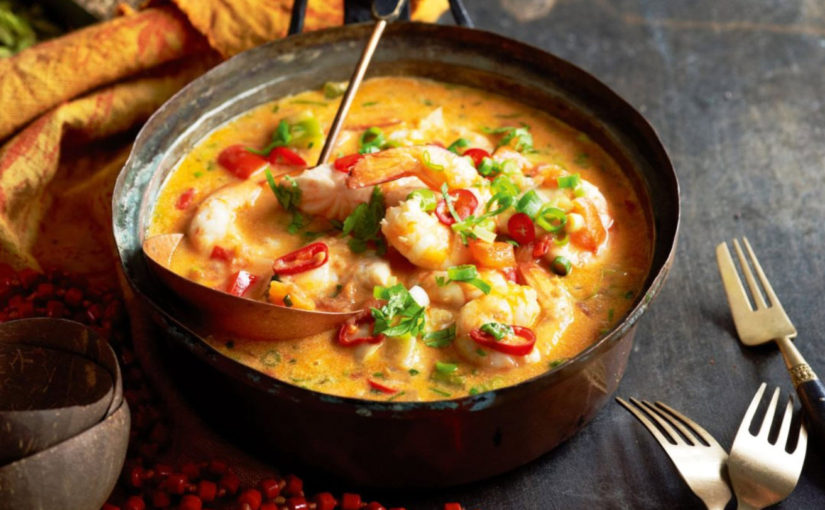One of the problems with a social media “echo chamber” is that you are unable to compare things.
That’s what an “echo chamber” is.
It’s talk and “news” about what you want to hear, and fences and barriers to what you do not want to hear.
You listen (day in, and day out) all about how great you are, and how bad everyone else is. And you know, there are no REAL comparisons. Just “rah, rah for us“. And those “other guys…” Well, “they are bad because of [place reason here].”
It’s a problem with all social media. And all these efforts to get rid of “hate” and other opinions that might offend tends to further strengthen the walls that surround these echo chambers. Eventually, all you and your friends within the chambers here is what you want to hear.
Well, we are going to make some comparisons to illustrate the dangers of echo chambers. Whether it is alt-right, or alt-left. And we are going to do it using something neutral.
Let’s look at school lunches.
We will start with a nation that is doing it right. We are going to talk about France. On a scale of 0 to 10, I rate them a 9. Why a 9? Well, they used to serve wine with the school lunches, don’t you know. But stopped doing so in the 1970’s.
Many parents would place one alcoholic drink of their choice in the child’s basket to take to school. Often half a litre of wine, cider, or beer depending on the region. Where there were cases of head teachers disallowing the drink be given to children, it’s said that some parents encouraged the children to drink their wine before they go to school, over breakfast. ... As recent as it may seem, it was only in September 1981, shortly after the election of François Mitterrand, that alcoholic drinks were banned from high schools once and for all, when water became the only drink encouraged at the table. “In canteens and school restaurants, no alcoholic beverages are to be served, even if water is cut off,” said Alain Savary, Minister of National Education at the time. -Culture Trip
So it’s a 9, not a 10.
France used to allow schoolchildren to sup wine in between lessons, which is almost unbelievable compared to today’s society. In fact, before the 1950s, French children were not only allowed to drink wine, beer or cider in the canteen, but they were encouraged to do so. -Why French Schoolchildren Used To Drink Wine Between L…
France
Maybe no one is drinking wine, but they do actually have nice lunches and a generous amount of time to enjoy and savor them.
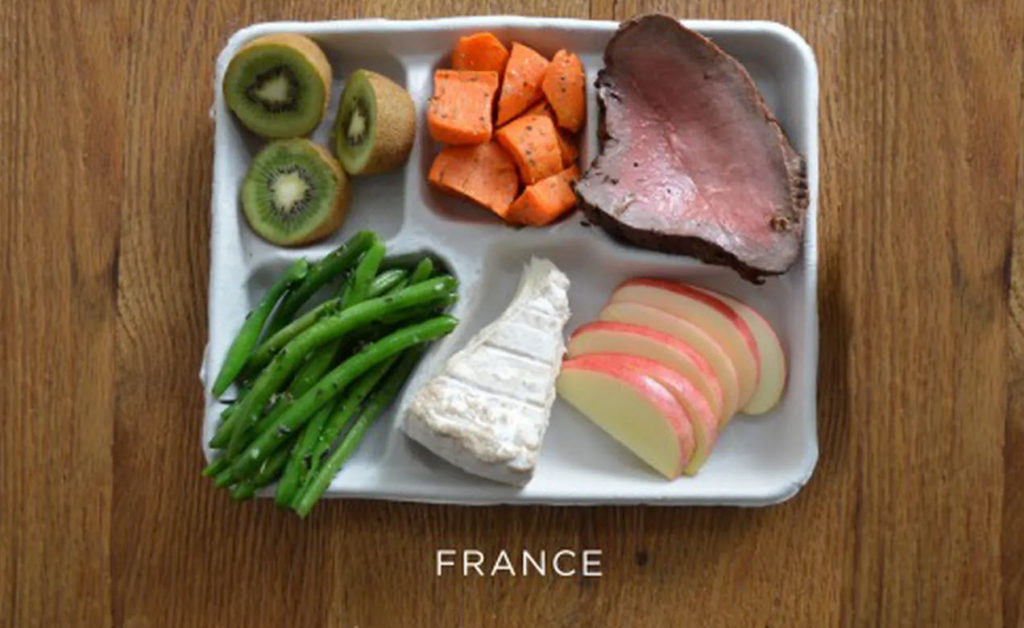
Even the approach to lunch is different. For instance, a typical school lunch in France includes “courses”, including an appetizer, an entrée, and a dessert, accompanied by water or milk. On any given day, a French school lunch could include: A Typical School Lunch in France. Fresh bread and salad; Veal scallops or baked fish with lemon sauce -French vs American School Lunches - Bistro Chic
French school lunches are very different from those in most other countries, especially those in the U.S.
French children are in school all day, even in the maternelle (roughly equivalent to U.S. kindergarden) and in the pre-school before that. Education covers life at large, including nutrition and meals.
For the French, learning how to eat a meal and appreciate diverse foods is like learning how to read, write and do arithmetic. It’s not an after-thought, or a thing that you must do as you rush from task to task, as is done in America today.
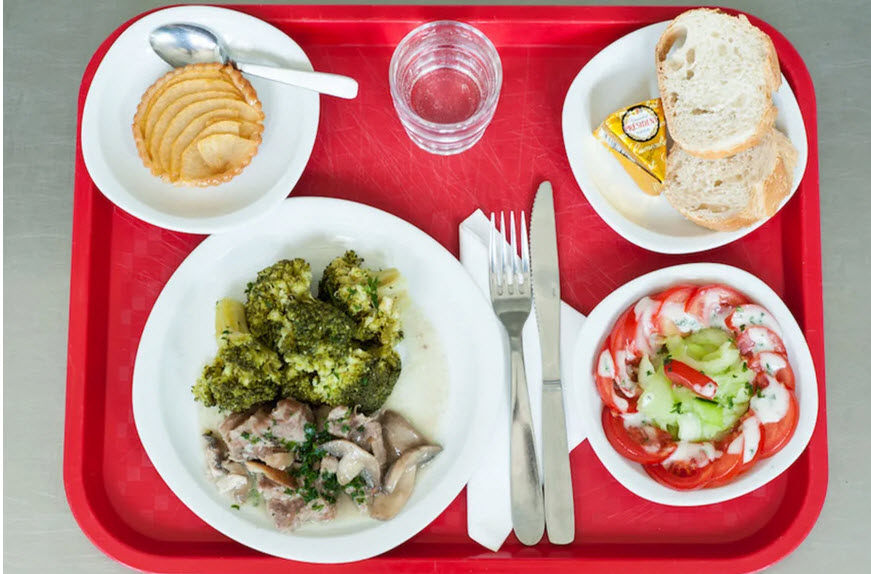
Lunch is the main meal of the day for children. In French schools this meal has four courses:
- Vegetable starter: leafy green salad or sliced or grated vegetables.
- The warm main dish, which includes a vegetable side dish.
- Cheese course.
- Dessert is fresh fruit four times a week with a sweet treat on the fifth day.
The Ministry of National Education requires that the children sit at the lunch table for at least 30 minutes, in order to eat a civilized meal.
The municipal government is responsible for operating the cantine, now more appropriately called the restaurant scolaire, and adhering to the national nutritional requirements which include:
- Within any four-week period (20 meals), only a maximum of four main dishes and three desserts can be high fat.
- Similarly, fried food is limited to four meals per month, likely the same four high-fat main dishes.
- Ketchup can only be served once per week, typically with the once-per-week fries, and only a limited amount provided with the meal. Many school simply don’t serve the high-sugar high-salt ketchup at all.
- No sweetened and flavored milk, water is served.
- No daily menu may be repeated within a month.
The municipal government can set prices within the constraints of the national law’s maximum limit and sliding scale.
The result is that, on average, a school lunch costs something like €2.30–2.80. The very wealthiest families might pay €5.40 per meal while those with the lowest of incomes pay €0.15 and free meals are available for those who can’t pay.
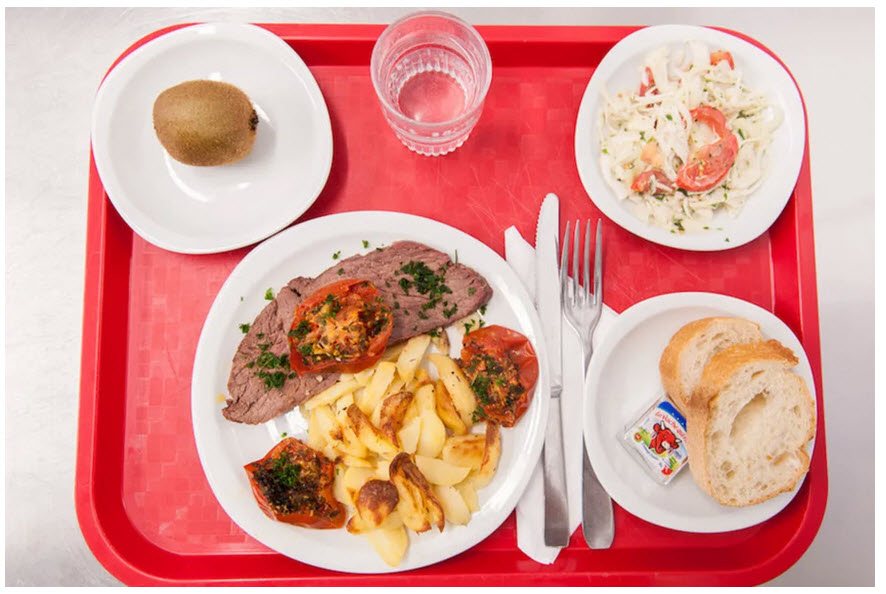
American expats have been commenting on how different the rest of the world is compared to America “the best nation”. And they are very angry at being so “hood winked” and lied to.
Growing up, I never really paid attention to the nutritional content in my school’s lunch program. But now, after having children of my own, I’m concerned about what food they are eating at daycare, and eventually, what they will be eating in their elementary school. The US standards for school food are extremely low. Much lower than that of some European countries, particularly France. Let’s just say if there was a World Cup for school lunch nutrition, France would be kicking our tails right now! When you compare French and American school lunches, it is quite apparent why childhood obesity rates are growing in the US. American schools serve lunches that consist of highly processed foods, loaded with sodium, calories, saturated fat, preservatives, etc. And very little of what they serve even resembles real food.
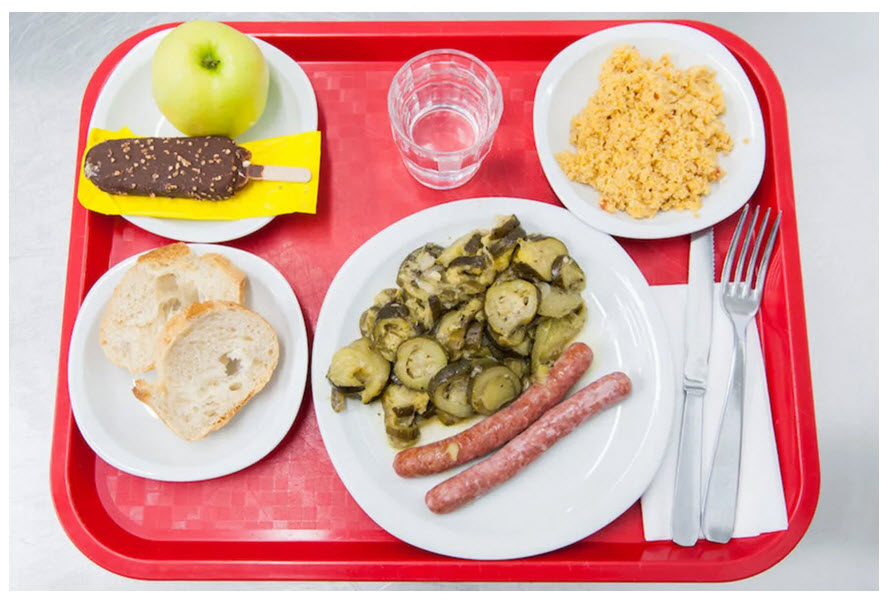
I walked into the dining room to see tables of four already set—silverware, silver breadbasket, off-white ceramic plates, cloth napkins, clear glasses, and water pitchers laid out ready for lunch. I was standing inside my children's public elementary school cafeteria, or "cantine" as the French call it, in our local town near Annecy, France. As part of my research into why French kids are better able to support healthy weight, the local city council gave me a tour of the public school's cantine and kitchen and let me ask any question that came to mind. There are many theories as to why French people, and French children in particular, do not suffer from weight problems, obesity, diabetes, and hypertension like their American counterparts. Eating moderate quantities of fresh and freshly prepared food at set times of the day is definitely one of the most convincing reasons why. Daily exercise, in the form of three recess periods (two 15-minute and one 60-minute recess every day) and walking or biking to and from school, is another. So what do French kids eat at school? Menus are set up two months in advance by the cantine management staff and then sent to a certified dietitian who makes small "corrections." The dietitian might take out a small chocolate éclair and replace it with a kiwi for dessert if she thinks there's too much sugar that week. Or she may modify suggested menus by adding more or fewer carbohydrates, vegetables, fruits, or protein to keep the balance right. Almost all foods are prepared right in the kitchen; they're not ready-made frozen. This means mashed potatoes, most desserts, salads, soups, and certainly the main dishes are prepared daily. Treats are included—the occasional slice of tart, a dollop of ice cream, a delicacy from the local pastry shop. (Check out these photos of a school lunch being prepared on premises.) Of note: French elementary school students don't go to school on Wednesdays, so that's why there are only four meals.
Another plus for France. Wednesdays are off.
Conversely, in France all school lunches are freshly prepared with real food, not prepackaged. Even the approach to lunch is different. For instance, a typical school lunch in France includes “courses”, including an appetizer, an entrée, and a dessert, accompanied by water or milk. On any given day, a French school lunch could include:
A Typical School Lunch in France…
-
-
- Fresh bread and salad
- Veal scallops or baked fish with lemon sauce
- Fruit and yogurt
- Water or white milk
-
Compare that to…
A Typical School Lunch in the US…
-
-
- Frozen cheesey bread
- Frozen chicken fingers or fish sticks and fries
- Fried apples or chocolate pudding
- Flavored milk, juice, or soda
-
Furthermore, a typical school lunch in France lasts about an hour, reinforcing the French tradition of eating slowly and savoring your food.
In the US, children get roughly 20 minutes to finish their meal and socialize with friends, reinforcing the habit of eating fast and not really recognizing what your eating, let along the signs that you’re full.

Obviously, school lunch programs are not only to blame for childhood obesity rates and unhealthy childhood eating habits.
Children learn from their family and friends and even from television what is “good” and what is “bad” in regard to food and nutrition.
Still, what they learn in school and from their classmates about nutrition can stay with them for the rest of their lives…

In elementary and high school, my family could never really afford the daily school-provided lunches, which included sloppy joes, French fries, and chicken fingers. At the time, I really wished that I could afford the hot lunch so that I could be like everyone else. But what I realize now is how lucky I am that I did NOT eat those lunches. Instead, I would brown bag my lunch with a salad or a sandwich and whatever fruit or dessert we had in the house. By doing this, I not only saved money, but I learned the basics of healthy eating at a very young age and how to differentiate processed food from real, nutritious food. Fast forward 50 years and I am nearly disgusted to think about what was served to my classmates back then, and even more disgusted that they still serve such unhealthy food in schools today. I understand that American schools and districts have certain policies about food and that any food is better than none for kids whose parents can’t afford to feed them. But there’s no reason why we can’t serve our children healthy and real food.
From preschool through highschool, the meals served at school cafeterias (les cantines) in France usually consist of five-course meals. An appetizer, main dish, salad or vegetable, cheese or yogurt and dessert. Bread may or may not be an option depending on the meal. (Pictured above is a school lunch from a high school).
"All our fruits, vegetables, fish, and meat are sourced locally, some of them from local farms," according to Dany Cahuzac, the city counselor in charge of school matters, including the cantine. The local bakery delivers bread, a staple of every French meal, every morning. And every two days, there is at least one organic item on the menu. Once a month, an entirely organic meal is served. The only drink offered at lunchtime is filtered tap water, served in glass pitchers.
If you’re not from France, you might be surprised to learn that the cafeteria meals in French schools are normal meals a French family might serve at home. French fries are also a popular food item in France but is not served more than once or twice a week as part of a school lunch.
Another French school meal…
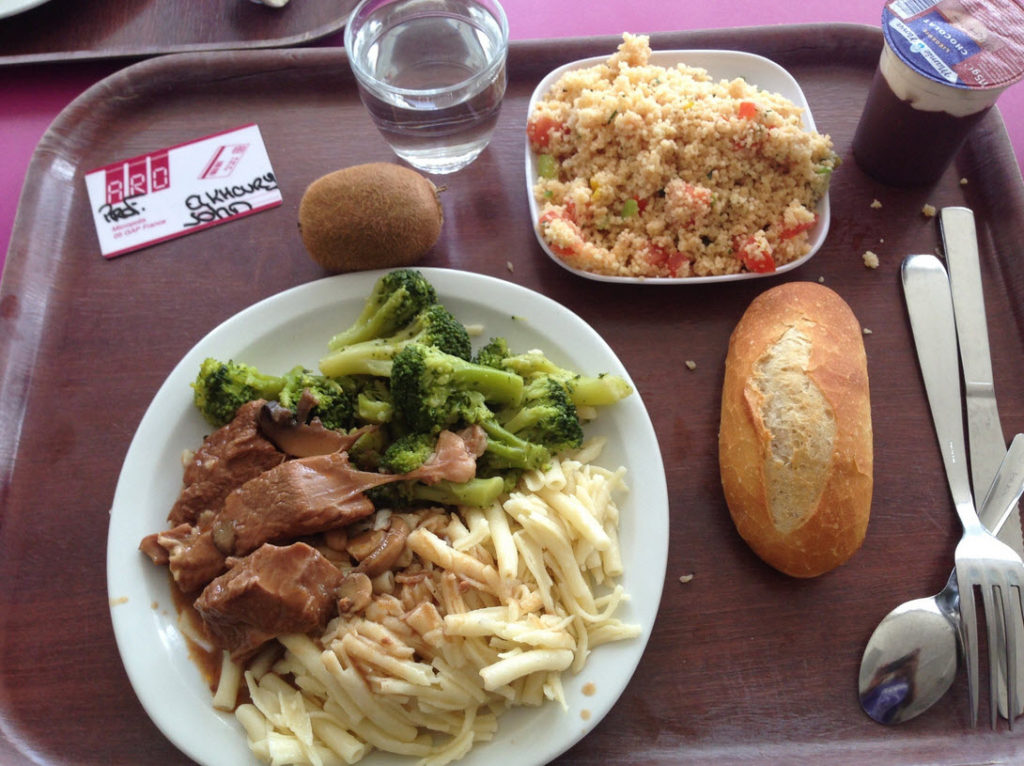
In the U.S., Time magazine’s “School Lunches in France: Nursery-School Gourmets” seems to have been one of the articles that drew significant attention in America to French school menus.
Consider the CBS News story “Why my child will be your child’s boss”, which explained how Swiss school children are regularly taken into the forest and allowed — no, required — to use saws.
Or the Lenore Skenzay’s book Free-Range Kids describes how a U.S. high school principal threatened to suspend a group of seniors (that is, 18 years old, in their final year of school) for the “dangerous act” of riding their bicycles to school, and a group of parents protested because their 17- and 18-year old children were sent home from school on a train without an adult supervisor.
Meanwhile Swiss children as young as three are given saws to play with, and their kindergarten system advises parents to let 4- and 5-year-old children walk to school alone.
As the children come streaming into the cantine, they sit down at tables of four that are already set and wait for older student volunteers to bring the first course to their table. The child who sits in the designated "red" chair is the only one who is allowed to get up to fetch more water in the pitcher, extra bread for the breadbasket, or to ask for extra food for the table. After finishing the first course (often a salad), volunteers bring the main course platter to the table and the children serve themselves. A cheese course follows (often a yogurt or small piece of Camembert, for example), and then dessert (more often than not, fresh fruit). "Eating a balanced meal while sitting down calmly is important in the development of a healthy child," adds Cahuzac. "It helps them to digest food properly, avoid stomachaches, and avoid sapped energy levels in the afternoon."
Then there are American school lunches and the concept of ketchup as a vegetable and frozen pizza as a vegetable.
Ronald Reagan’s FY1982 budget proposed US$57 billion in spending cuts, This budget was modified and passed as the Gramm-Latta Budget, cutting US$1 billion from the school lunch program while significantly increasing military spending.
The U.S. Department of Agriculture or USDA was then tasked with the impossible task of maintaining nutritional requirements for school lunches despite the loss of a billion dollars in funding.
On September 3, 1981, the U.S. Secretary of Agriculture announced a joint proposal by the USDA and the Food and Drug Administration to reclassify ketchup and pickle relish as vegetables.
Public outrage led to the eventual retirement of this specific proposal. However…
By 2011, USDA standards accepted just two tablespoons or 30 ml of tomato paste as counting for a full serving of vegetables. This allows a slice of cheese and meat pizza to also count as a full serving of vegetables.
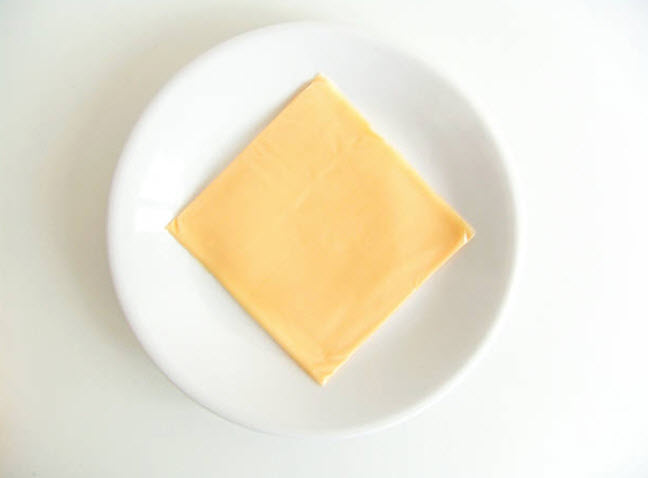
The USDA wanted to change this to require at least a half-cup or 118 ml of tomato paste before counting it as a full serving of vegetables, also requiring more green vegetables and limiting the amount of potatoes served to one cup per week and thus significantly cutting back on the amount of French fries.
But…
The U.S. Congress would have nothing to do with that healthy nonsense, and quickly passed a bill barring the USDA from changing its existing nutritional guidelines.
This was an enormous victory for manufacturers of pre-processed French fries and frozen pizza!
The American Frozen Food Institute is a trade association that lobbied heavily and successfully on behalf of frozen pizza manufacturers including ConAgra and Schwan Food Company, and French fry manufacturers McCain Foods Ltd and J.R. Simplot Company, the last of which was already a supplier to McDonald’s.

Meanwhile the actual French people, including their school children, eat only a tiny fraction of the amount of “French fries” consumed by their American equivalents.
So what DO American school children eat?
United States
I suppose that this picture is the IDEAL American lunch meal…
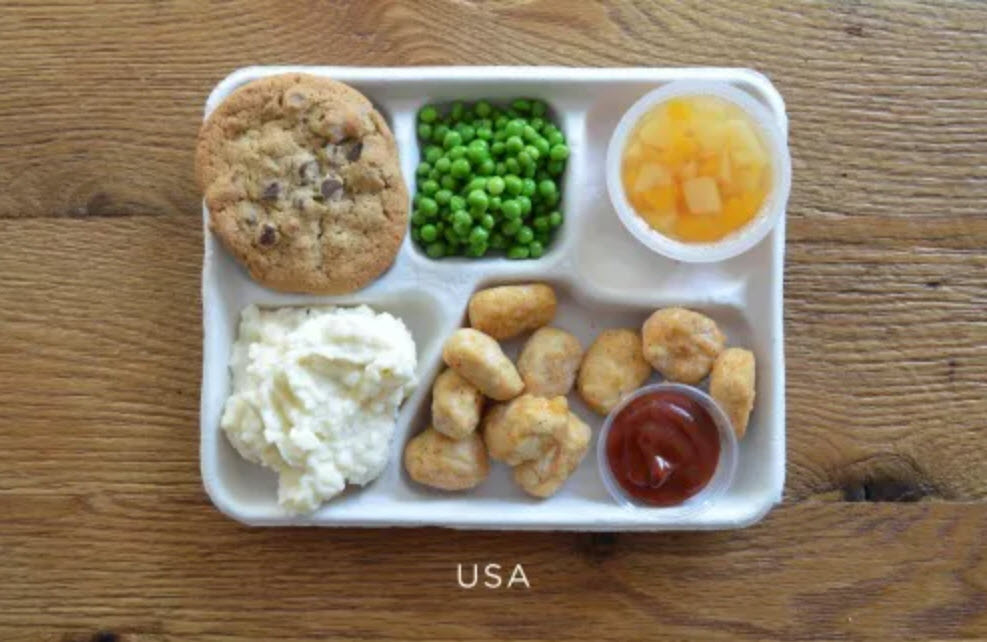
The ideal consists of processed meat, pre-processed instant potatoes with sugar-laden ketchup, a sugar cookie, dessert of canned fruit in a sugar sauce, and a serving of vegetables.
The IDEAL, that is.
American schoolchildren, in general, aren’t as accustomed to eating the same fresh, healthy meals as some of their global neighbors. In the photo series above, the American meal includes chicken nuggets, peas, mixed fruit, mashed potatoes, and a cookie. While that satisfies certain federal guidelines for nutrition, there’s plenty here (preservatives, processed sugar) that’s less than ideal.
Still, the meal doesn’t look that bad.
Of course, as anyone who went to US public schools knows, the meals are rarely this aesthetically appealing.
Plenty of them look like this…
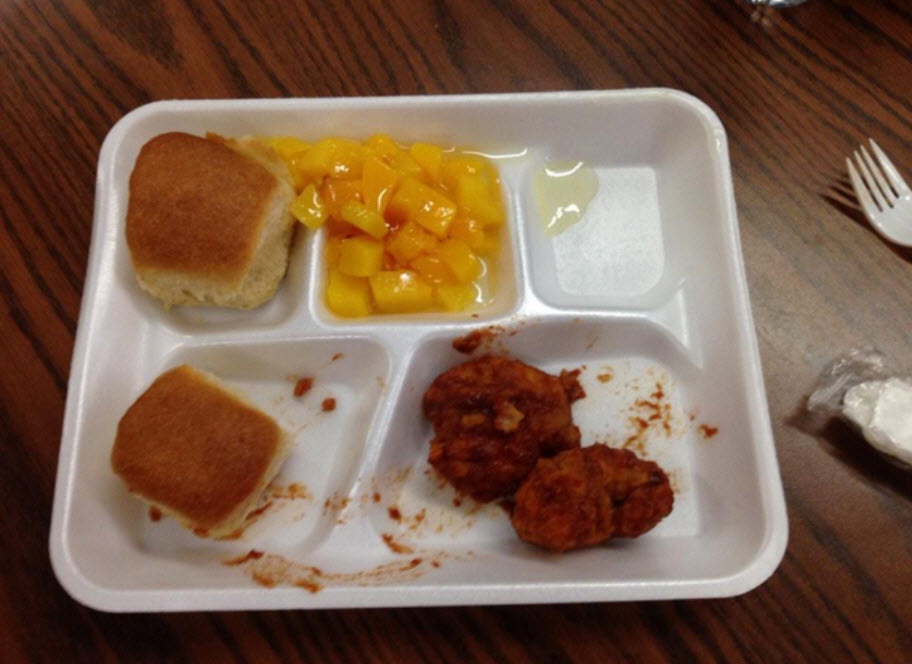
Had a very #healthylunch today. The apple definitely made up for the "mystery mush" #ThanksMichelleObama pic.twitter.com/RWCnQRCxJK
— Hunter Whitney (@huntwhitney4) November 13, 2014
“Today, class, we’ll be having brown.”
For an explanation of the #ThanksMichelleObama hashtag, read this piece by Vox’s Libby Nelson.
Throughout the United States, the classic milk carton of white milk is served to the children; The classic milk carton.
"Unfortunately, the variety served at the schools my children went to in the U.S. was usually a rotating menu of burgers, burritos, and tacos. Some middle schools and high schools in California even served McDonald’s."
Complaining about school lunch is a time-honored tradition. But teens on Twitter have found someone new to blame, tweeting photos of tiny and/or disgusting-looking school lunches with the hashtag #ThanksMichelleObama:
This is my lunch. I'm in high school. #ThanksMichelleObama pic.twitter.com/02t4MScBIe
— Maya Wuertz (@wuertznightmare) November 17, 2014
Because healthy eating, particularly for kids, is one of the Michelle Obama’s signature issues, it makes sense that she’d be associated with changes to the federal school lunch program.
But those changes actually started with Congress and were put into place by the US Department of Agriculture.
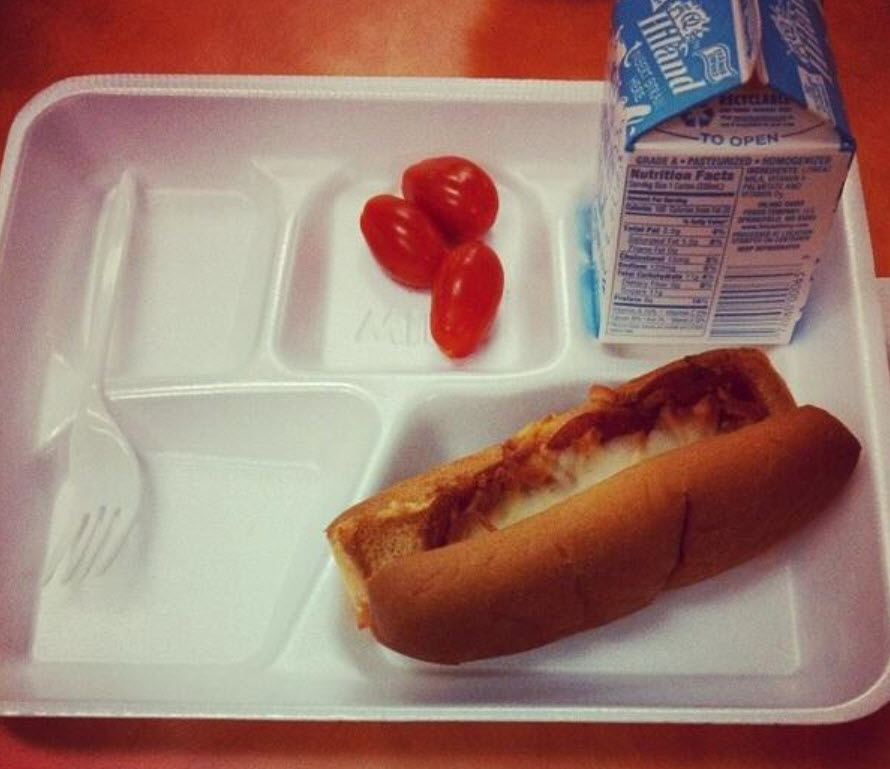
Congress passed the Healthy, Hunger-Free Kids Act in 2010, requiring the federal government to issue school lunch guidelines based on recommendations from the Institute of Medicine.
Based on the photos above, the act might not always be living up to its name. Let’s look at what is going on in some better detail…
Why the American federal government changed school lunches
#ThanksMichelleObama pic.twitter.com/lNo2WshiXM
— Garrett Freeman I (@garrettfreeman4) September 29, 2014
The regulations from the US Department of Agriculture require school lunches to meet higher nutritional standards. Which is a good thing.
Meals are now supposed to have more whole grains, less meat and less sodium than in the past, and they have to include at least one fruit or vegetable.
Schools also have to offer a wide variety of vegetables — in one week, they have to offer starches (such as potatoes), dark green vegetables (spinach, kale, and other greens), red or orange vegetables (such as carrots or beets), and beans or peas.
If students refuse to put a vegetable or fruit on their tray, the school isn’t reimbursed for that meal.
Thus it results in all sorts of strange looking meals…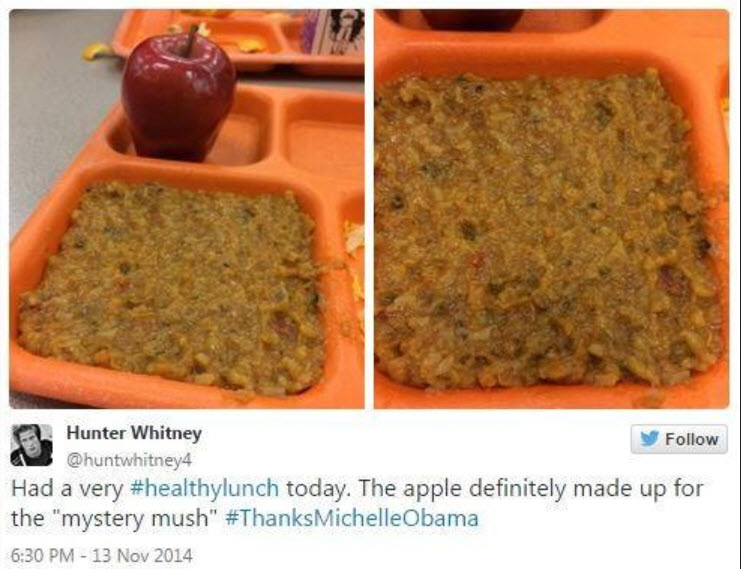
Why American school lunches look so gross
Sometimes, you can never have enough ketchup. #ThanksMichelleObama #USpoli pic.twitter.com/N0wNy1Wzfo
— Jimmydubyyc (@jimmydubyyc) November 21, 2014
Anybody who went to school can tell you that gross-looking school lunches aren’t new. But the new school lunch guidelines sound like they should lead to healthy, whole-grain rich meals — not the pizza, chicken nuggets, and hamburgers that were mainstays of school lunches in the past.
But…
But…
Why hasn’t it worked out that way?
Partly it’s because school lunches need to be cheap.
When California began a pilot program of serving fresh, local food one day a week, one district learned that two free-range chicken drumsticks for a high school student would cost 80 cents, more than the 60 cents they’re supposed to spend on an entree.
Healthier meals also require equipment that school kitchens, set up to reheat and serve batches of processed foods, sometimes don’t have.
That's correct, boys and girls, the modern schools have kitchens that do not make and cook food. they are designed to reheat pre-processed synthetic food elements.
Districts are also allowed to make agreements with food companies to turn the raw ingredients they get from the US Department of Agriculture into processed foods…
… ensuring they have a constant supply of chicken nuggets.
Schools didn’t stop offering pizza at lunch, a study in the journal Childhood Obesity found: they just started offering healthier pizza, whatever “healthier pizza” means. (It probably doesn’t taste as good.)
Does anyone know what a “healthier pizza” is?
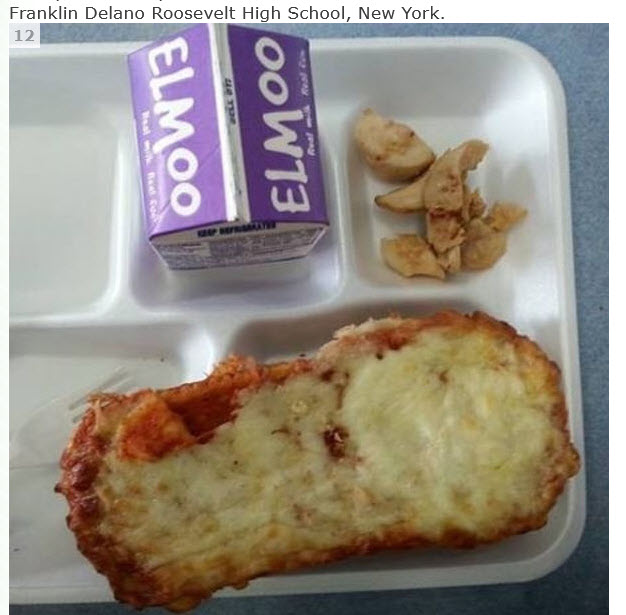
Why American school vending machines are empty
Why are the kids emptying out the vending machines, and throwing away their lunches?
#ThanksMichelleObama pic.twitter.com/QTGW9O7M55
— ash (@AshtynMinnard) September 11, 2014
#ThanksMichelleObama is almost accurate here, if you can imagine Michelle Obama standing in for the US Department of Agriculture. (It is part of the executive branch!)
For the first time, the USDA now regulates foods that schools sell outside of the school lunch program — the sweet, salty snacks in vending machines and a la carte lines.
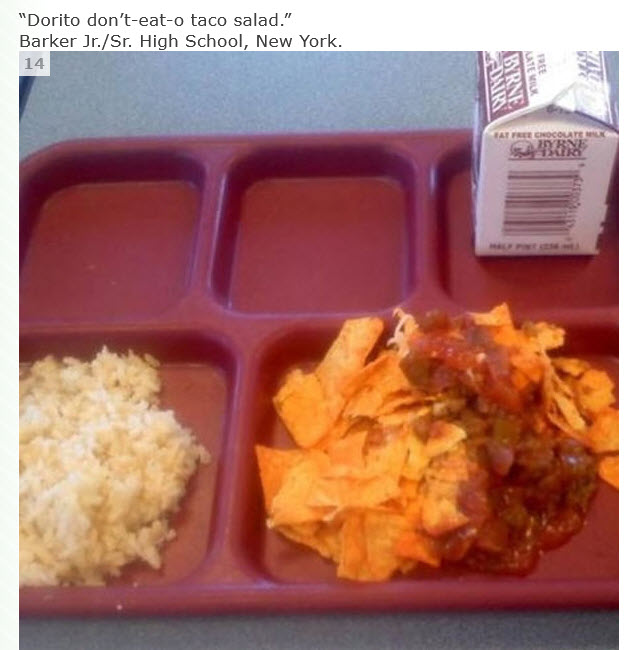
American students are used to eat a lot of unhealthy food during the school day.
In the 2005 school year, the USDA says, students drank 452 million sodas, 26 million diet sodas, and 864 million fruit drinks. They ate 763 million candy bars and 1.4 billion desserts.
On average, high school students who ate those foods consumed an extra 277 calories a day, the majority of them empty calories from foods without much nutritional value.
To compensate, we can see the great healthy meals that are offered in the American school dining halls…
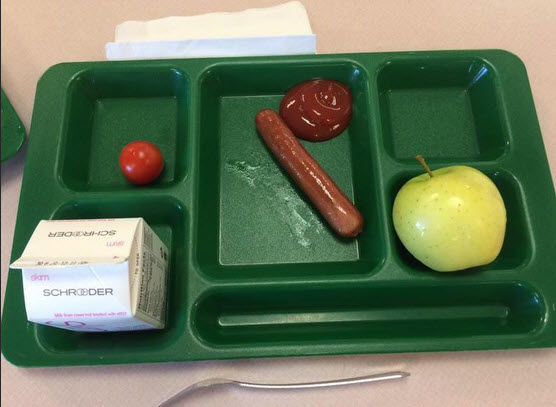
But beginning this school year, everything sold in schools — even outside the national school lunch program — has to meet nutrition guidelines.
Snacks must be under 200 calories, and foods must have some nutritional value — rich in whole grains, or have fruit, vegetables, protein, or dairy as a main ingredient, or contain 10 percent of the recommended daily value of important nutrients.
Sounds good.
But when you have a central bureaucracy dictating everything and bureaucrats deciding adaptation of policy guidelines, along with the toxic influences of big-food, big-education, and big-unions you end up getting what we see here.
So it’s not just Michelle Obama to blame — in fact, technically, she had nothing to do with the regulations.
But that’s the way America is today.
And that is why we see Americans are they are today.

Summary of the American nutrition system
The comedy Idiocracy has shown us the way…
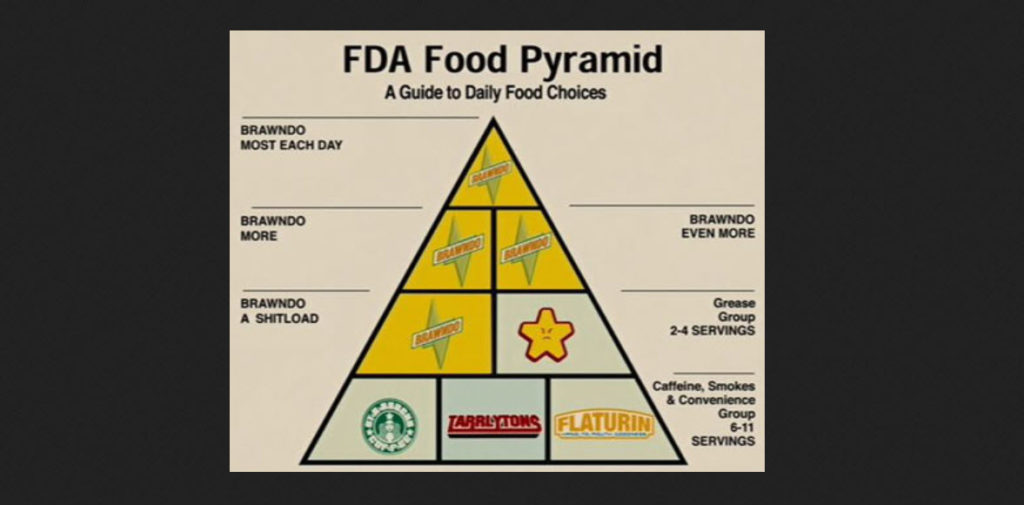
From AlterNet…
The 2006 cult comedy Idiocracy is having its moment in the sun. Written and directed by Mike Judge, creator of “Beavis & Butthead,” Idiocracy envisions a future corporate American wasteland where Costco is as large as a small city, the food pyramid consists entirely of fast food, and the president of the United States (Terry Crews) is a five-time "Ultimate Smackdown" professional wrestling champion and ex-porn star. “So you’re smart, huh?” President Dwayne Elizondo Mountain Dew Herbert Camacho says to hapless time traveler Joe “Not Sure” Bauers (Luke Wilson), an Average Joe chagrined to discover he’s now the smartest man in the country. “I thought your head would be bigger,” Camacho bellows. “Looks like a peanut!” Donald Trump's political ascendancy has made Idiocracy seem like prophecy. (Or, per a viral tweet by the film’s screenwriter, a “documentary.”) As satire, however, Idiocracy is uneven, precisely because recent events have already exceeded its most trenchant bits of lunacy. In the fictional Idiocracy future, Congress is full of idiots who do nothing but yell, “You’re a dick!” at the president. But those antics pale in comparison to stunts pulled by presumptive Republican presidential nominee Trump, a billionaire real-estate developer and reality TV show star whose foreign policy proposals include telling China, Listen, you motherfuckers, we’re going to tax you 25 percent! In 2009, Trump purchased the rights to pro-wrestling show “Monday Night Raw” and then sold them back to the previous owner “for twice the price,” according to the World Wrestling Entertainment website. “Since then, the WWE Hall of Famer [has] focused on his ever-expanding real estate empire, his Emmy-nominated reality television show ‘The Apprentice’ and running for president of the United States.” Mike Judge may be a funny guy, but his mind isn’t exactly subtle. A decade ago when Idiocracy was released, he was already treading well-worn ground by envisioning a future where being unable to pay debts is a crime (see: the return of debtor’s prison), the Violence Channel dominates the networks (see: all of cable), and a plotless film about a farting white ass wins Best Screenplay at the Academy Awards (see: Swiss Army Man, starring Daniel Radcliffe as a farting corpse). To be sure, there is more than a grain of truth in Judge’s worry that educated people sound like “fags” to a population that speaks “a hybrid of hillbilly, valley girl, inner-city slang, and various grunts.” But in order to get the laughs, he went for low-hanging fruit, using eugenics as a plot device, romanticizing the effects of social engineering and coming perilously close to validating the dubious notion of IQ as a social sorting tool. The film opens with a voiceover explaining that rampant breeding among the dimwitted has undone civilization. After 500 years of exponential idiocy, corporate America has responded by catering to the lowest common denominator. Thus, future Starbucks offers hand jobs. Fuddruckers has become Buttfuckers. Fox News is anchored by pro-wrestlers. Costco gives out law degrees. And the company behind the energy drink Brawndo owns the FDA, FCC and USDA. But the film got the power dynamic backward, thereby softballing its critique. As Adam Johnson pointed out on AlterNet, it decided to highlight “the problem—in this case political ignorance—without addressing its primary culprit: the consolidation of media into large corporations, a PR-fueled think tank industry fed by billionaires designed to promote toxic right-wing canards… and a decades-long corporate assault on K-12 and postsecondary education.”
In my opinion, Idiocracy is one of the great science-fiction films of the past decade. When most people think of science-fiction it’s an action packed Star Wars or Star Trek style space opera with space ships, robots, lasers and lots of action. While these films can be extremely entertaining, the actual “science” part of the equation is somewhat lacking. In my opinion the the most interesting science-fiction films are those based on an event or series of events occurring on Earth and the impact of these events on society.
What makes this form of science-fiction particularly interesting is that a memorable world is set up to allow the film to provide an insight on our current society.
Idiocracy vividly creates a future version of a polluted America where a handful of corporations seemingly run all commerce and social services, advertising is all pervasive and the media is dumbed down to the lowest common denominator. Idiocracy is a very funny film, but also one that asks a lot of uncomfortable questions about where society is heading…
U.K. school lunch
Now for comparison purposes let’s look at one of the “five eye” nations. This is the United Kingdom. You see, the group of five nations share culture, intelligence, society and other aspects of life with some minor differences (as long as it is permitted by the Untied States leadership).
These nations are;
- United States
- Canada
- UK
- Australia
- New Zealand
So you would assume that these nations would have a similar lunch menu, but exercise some degree of autonomy in it’s selection…
And that is exactly what happened.
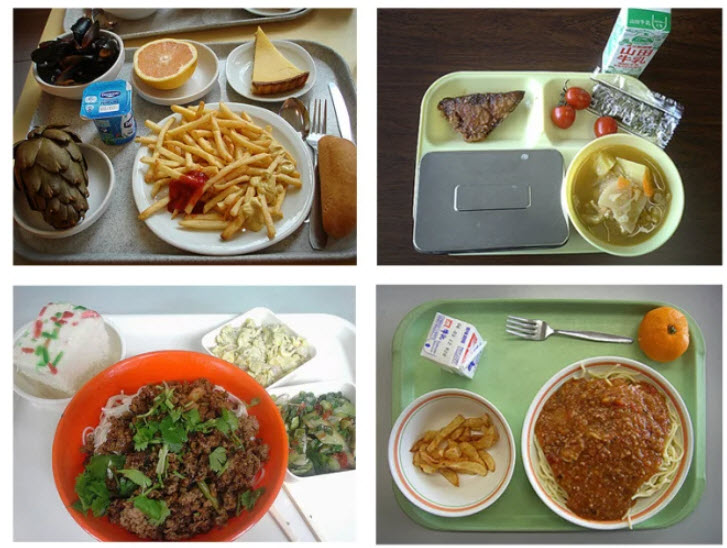
A fine copy of American lunches, only with greater portion sizes, less sugars, and less salt. I am going to go out on a limp and say that the UK is on the right path, and following the right direction. No it’s not perfect. But they are trying. They do care.
Other nations have been revamping their school food programs with more nutritious, sustainable food for the better part of the past decade.
Years before Jamie Oliver did his thing, East Ayrshire, Scotland launched a pilot program called Hungry for Success. That program went far beyond boosting nutrition. It also focused on nutrition education; trained cooks; put organic, local food in school meals; and made the cafeteria a cooler place to hang out.
So how’d it go over? A Worldwatch Institute report says 67 percent of the town’s children said school meals tasted better.
It was later adopted nationwide, and elements of the program were later picked up by the UK.
Granted it is much better than what is offered in the Untied States, but it is still heavily laden with salts, sugars and other unhealthy elements and typically devoid of fruits and raw vegetables.
Let’s look at Japan.
Japan
In response to growing obesity rates among children, Japan passed The Basic Law of Shokuiku in 2005. It requires kids to get nutrition and food origin education at all public schools.

Fittingly for a country with its own rich traditional cuisine, Japan takes its catered elementary school lunches very seriously.
More than just a meal, lunchtime is considered on par with school lessons in its educational importance. It also helps create a bond between schoolmates in a way that perhaps only sharing a meal can do.
Tokyo school lunches are planned by the school’s nutritionist and cooked onsite by a group of staff hired specifically for that task. They prepare big pots of soup and rice and such, which the students on lunch duty retrieve from the kitchen, wheel into the classroom on a big trolley and then dish out to their classmates—it’s a bit like a portable canteen. Outside Tokyo, school lunch centers will make and distribute the food to schools.
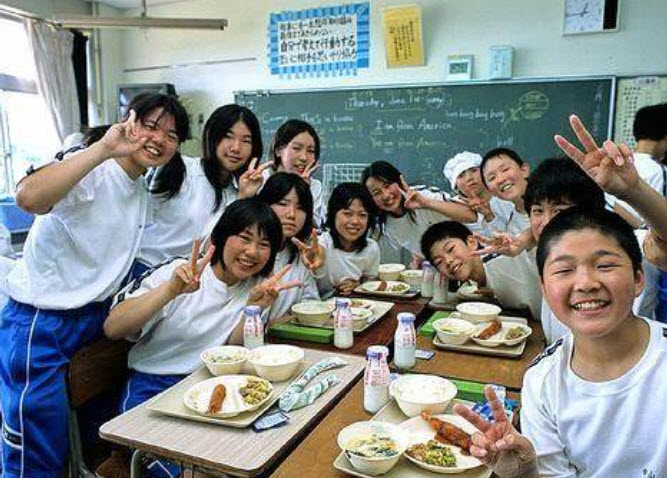
The students on lunch duty dress for the part, in a white kitchen cap and a long white smock-style apron. They also don a regular, flu-use medical mask. As the other students pass by with their trays they accept a bowl of each dish from the lunch-duty kids and take them back to their desks.
Utensils are also provided.
When the children return to their seats, they place their tray on the luncheon mat that they have brought from home and laid out on their desk. Also on the desk should be a pocket pack of tissues, a small hand towel and a cup. Students bring these items from home daily in a little bag that they usually hang off the side of their backpacks. Recently some schools are asking students to bring a toothbrush, too, for a post-lunch brush-up. Teachers eat the same kyuushoku catered lunch at their desks along with the students.
So what do they eat?
Most often rice, soup, a salad and a meat or fish dish.
A 200-milliliter bottle of milk is included daily, but once or twice a month coffee milk or a yogurt drink is served instead.
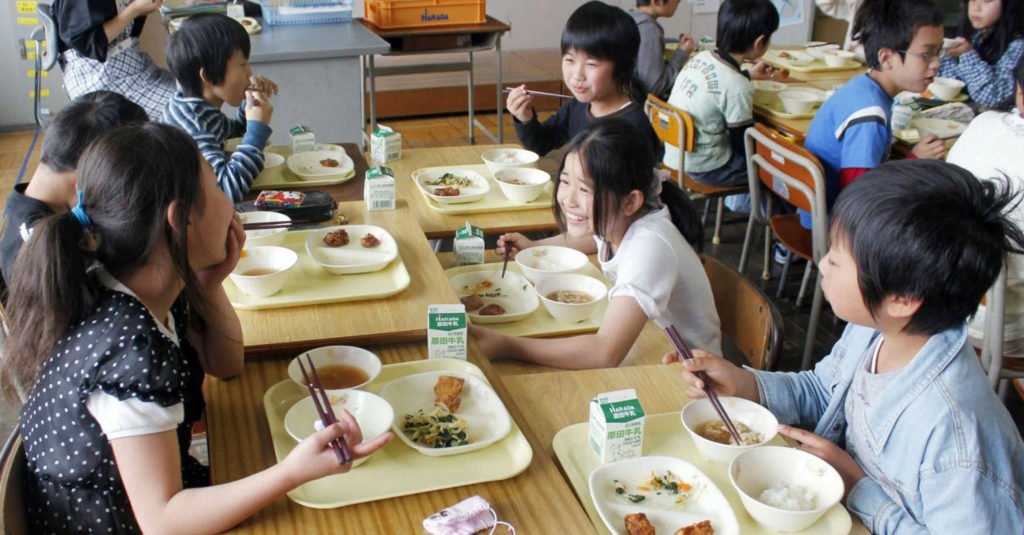
The rice dish is rarely plain white rice. Instead it will have something such as mushrooms or wakame kelp mixed through it. It also gets served as fried rice or pilaf. Occasionally the kids get noodles instead. Bread appears as the staple about once a month and almost certainly is sweet. Dessert is served once or twice a week, most often as a piece of fruit, but occasionally as a jelly or pudding.
The soup is most often miso soup, but a variety of soups are served, including other Japanese soups, such as the clear sumashi jiru, as well as Western-style pumpkin soup and Chinese-style egg soup, which make regular, monthly appearances.
Salads appear most days and come in a wide variety—wakame salad, bean sprout salad, French salad, potato salad—but all ingredients, even cucumber, are cooked to prevent an outbreak of stomach virus.
Meat dishes are often served atop rice as a donburi.
Fish is the main dish on average about once a week.

This is a rough guide, though, as the menu and the frequency of each type of dish differ according to the menu plan arranged by each school’s nutritionist.
The meals often reflect various festive events—both Japanese ones, with pumpkin served at the winter solstice, for example—and non-native ones, such as with a chocolate dessert on Valentine’s Day.
Parents pay for their children’s school lunches, but they don’t pay much; about ¥250 a meal in first and second grade, just under ¥300 in fifth and sixth grade, and midway between those in the middle years.
In line with broader Japanese society, schools here have become very aware of food allergies. The school entrance paperwork will include your child’s allergy information. Schools will likely cater for an allergic child by preparing her lunch without the allergic ingredients and placing it upon the kyuushoku trolley with her name on it.
Japan’s school-lunch system is said to have begun in Yamagata prefecture’s Tsuruoka city in 1889 when a priest-run elementary school served rice balls, grilled fish and pickles to students too poor to bring lunch to school. The move was widely recognized as a good thing, and schools across the nation began to follow suit.
The school lunch system teaches children etiquette, serving and clearing up skills, and aims to teach them to make healthy food choices and positive lifelong eating habits.
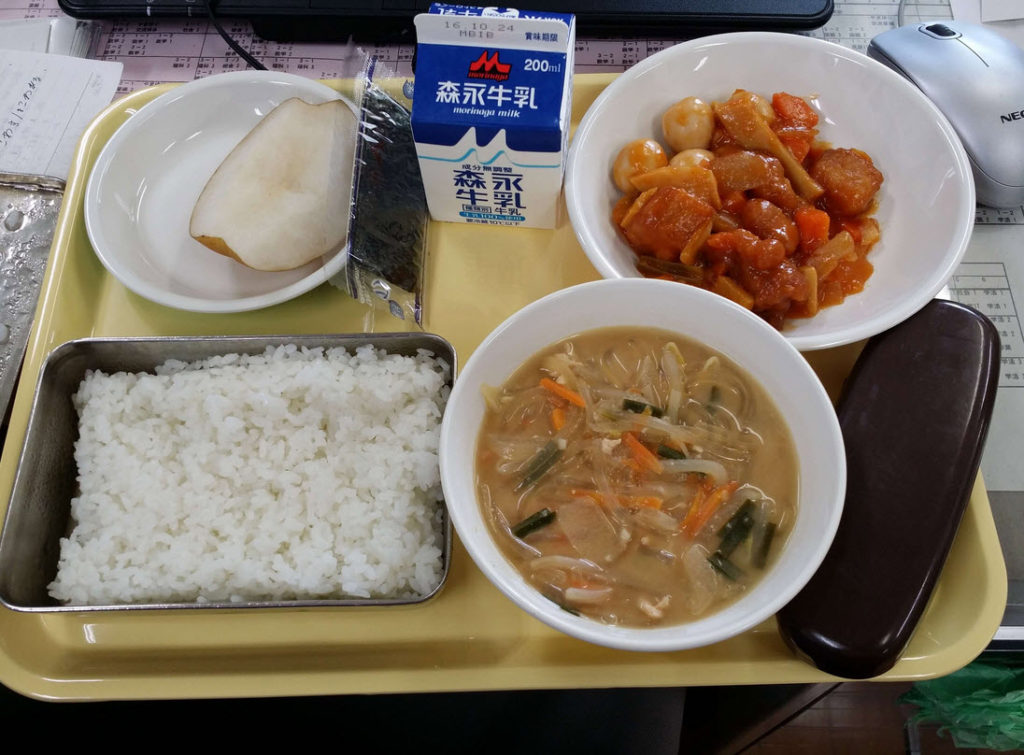
Since it also aims to have students try a wide range of food, teachers have traditionally encouraged them to eat all the food served to them.
Anecdotal accounts from sempai moms include a teacher insisting a student complete his lunch and him sitting there in front of it all the way through the post-lunch playtime and into the next lesson. Even back then the strictness to which the “please eat everything” rule was enforced varied according to the teacher, and today—in line with a shift in wider social values—such an extreme example is unlikely to be found.
Ideally, sharing a meal should be an enjoyable experience that unites a class by helping classmates get to know each other more intimately and understand one another better.
When Japanese parents reminisce together about their own elementary school days, talk of school lunches invariably emerges and, although spoken of fondly, the tastelessness of the dishes is usually the main topic.
It is a palpable bond for them.
Today’s school lunches have improved in taste, with both teachers and students praising them. It is amazing what happens when parents, and local administrators work side by side and maintain tradition and healthy care for the future of society.
And let’s look at China…
China
In China, the kids eat well, healthy food. The portions tend to be gargantuan. Seriously, but you are not going to get fat on rice, vegetables and fish, are you?

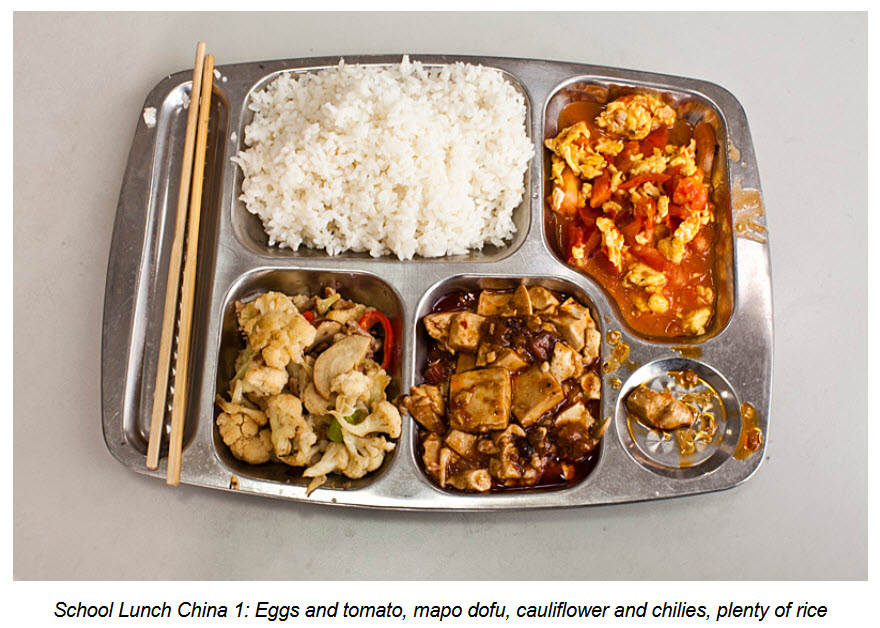
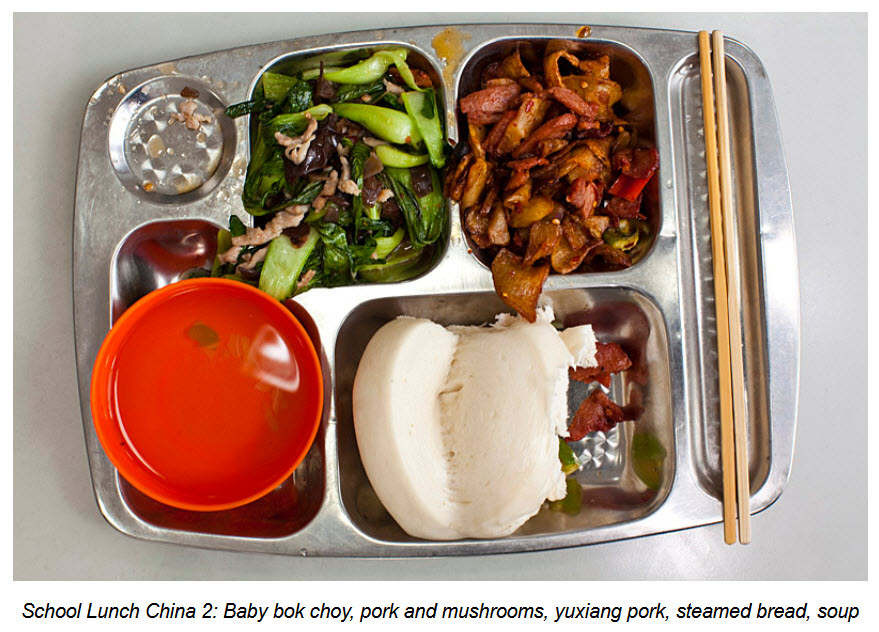
Dave took his China images at a college cafeteria in Chengdu. It was school holidays and the campus was nearly deserted, but the cafeteria appeared fully operational. And we were astounded to find at least 30 items -- not including mantou (steamed bread) and rice -- on offer. Fifteen yuan (a little over two US dollars) bought us the two meals above. With rice and mantou it was far more than we could eat. Mantou (which got hard as soon as it began to lose its heat in the unheated cafeteria) excepted the dishes were all quite good, delicious even. The stir-fried egg and tomato -- slightly sweet and very flavorful -- cauliflower (perfectly crisp-tender and touched with chili heat) and the baby bok choy (also perfectly done, tangled with tender strips of pork) were the stand-outs. If I were in Chengdu and keeping to a very strict budget I'd be frequenting university dining halls. Think of it -- a day's worth of well-prepared and decently healthy meals for about U$3.
The Global Times ran a nice photo collage on the meals that children eat throughout China it’s a pretty good essay. From the article, (and all credit to the writer)…
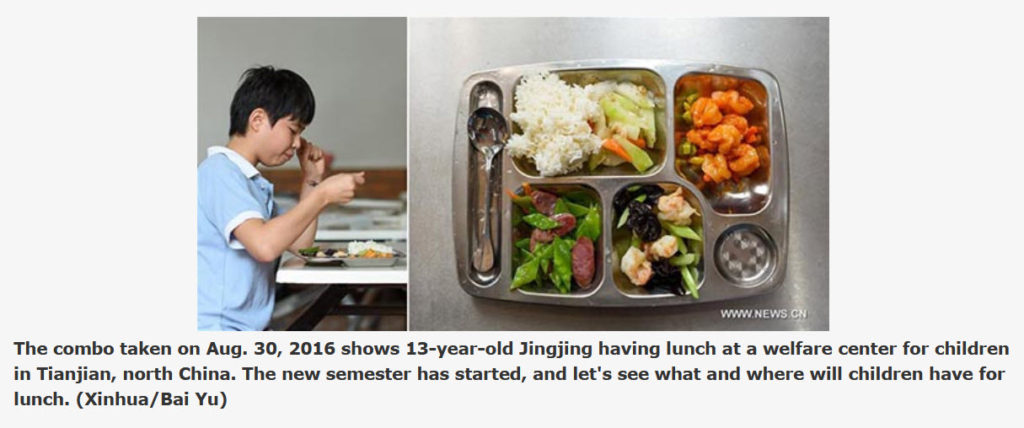
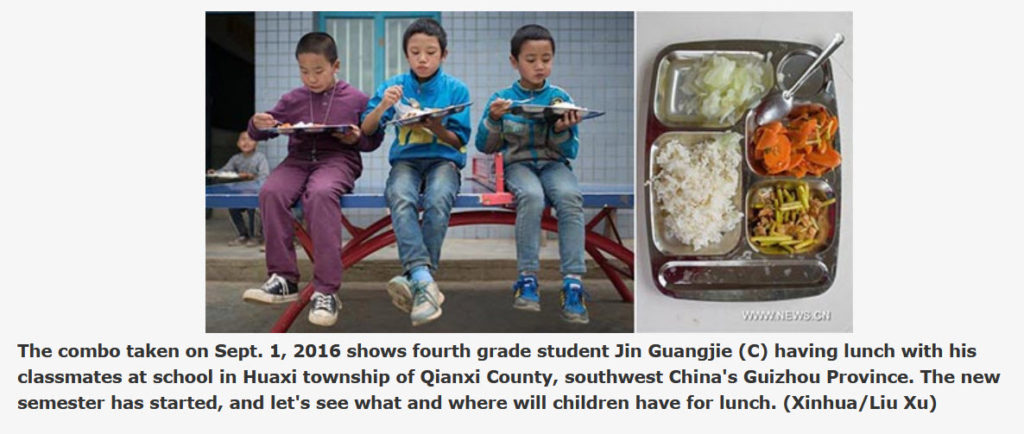

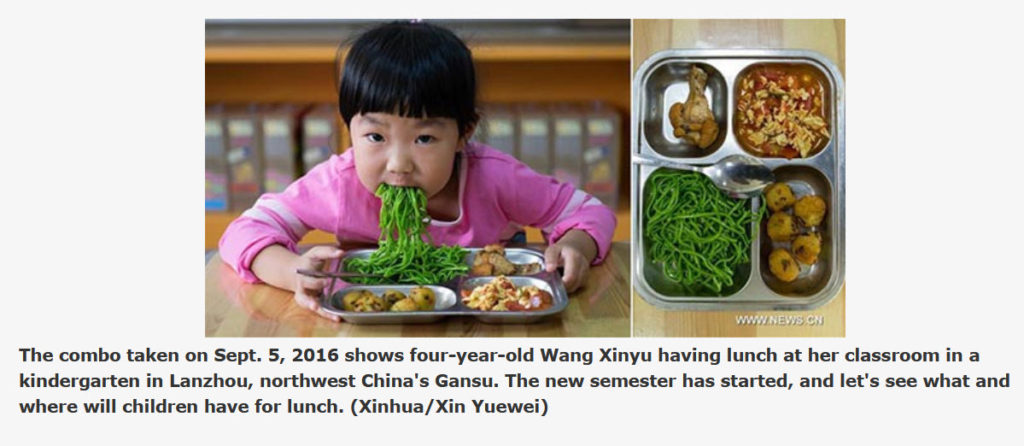
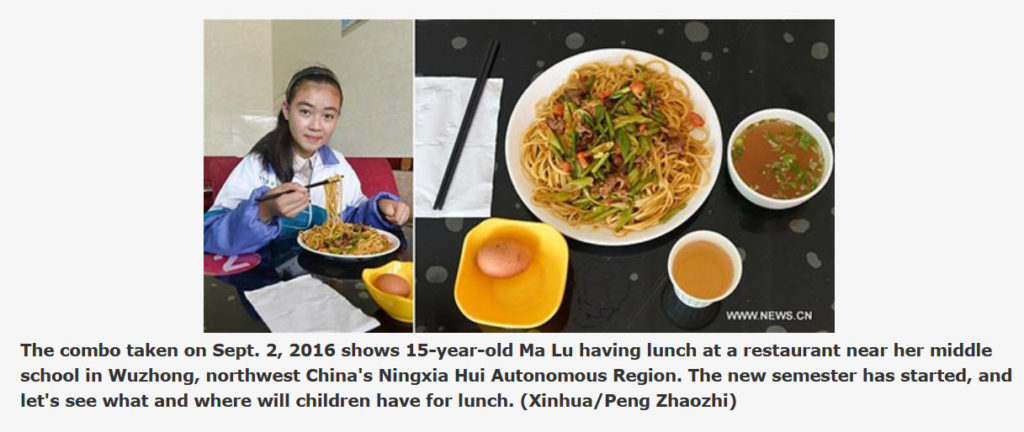

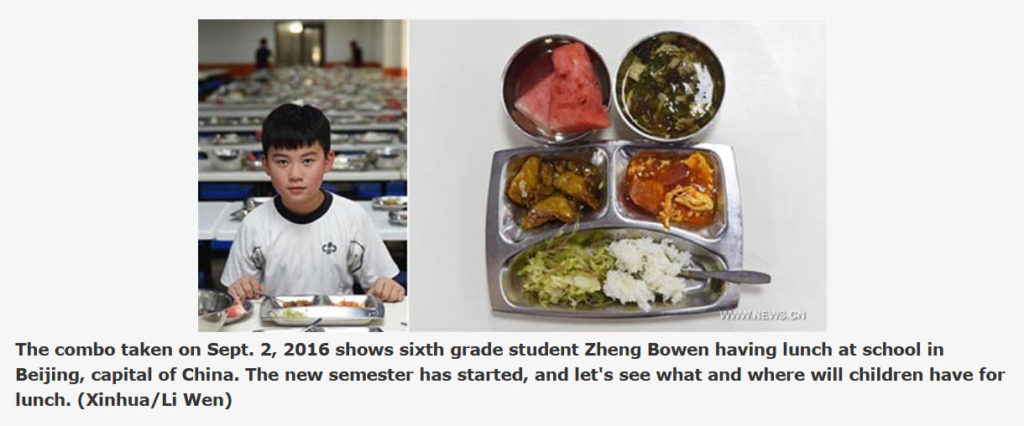
Brazil School Lunch
And Brazil…
Brazil’s school feeding program, the second largest in the world feeds 42 million of the country’s school children. Part of Brazil’s Zero Hunger Program, the school lunch program has not only helped reduce child hunger and malnutrition, but it has also started to change how children relate to and understand food, while promoting local agriculture.
Brazil’s constitution requires that 30 percent of the ingredients for school meals be sourced from local, family farms. In so doing, the country has helped some four million of the country’s small farmers and promoted rural development.
As do many countries around the world, Brazil has the double burden of malnutrition and obesity. Poor kids without access to sufficient, nutritious food have a growing access to junk food, and, as a result, obesity is on the rise. Public schools in Brazil are trying to tackle the problem—one of their most effective tools is school gardens. Kids grow their own food and decide what produce to use for their daily school meals, all while building a better understanding of their food and what it means to eat healthy.
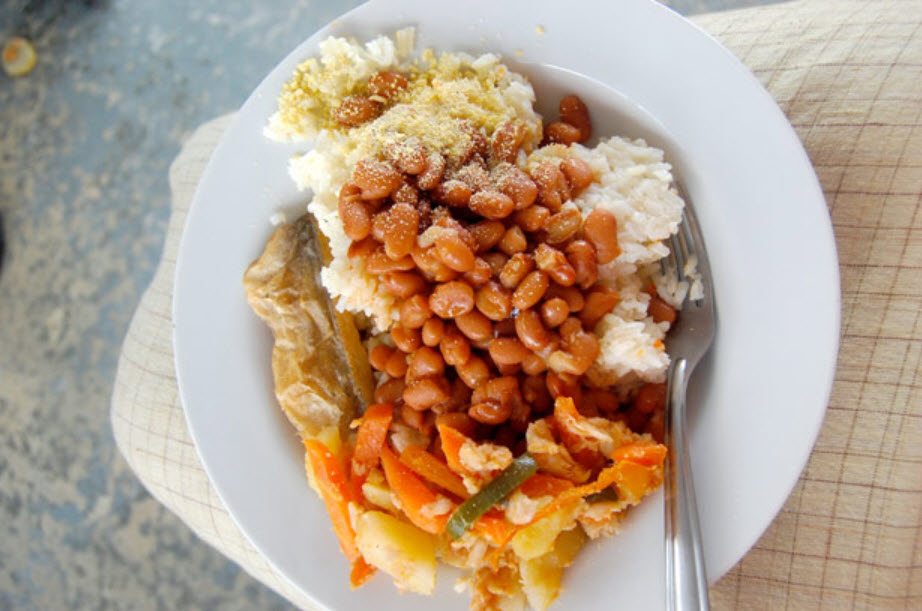
The Brazil lunch program has been praised the world over. Here’s some “take-a-ways” from The Tyee…
Lesson 1: Delegate decision-making power to local governments
For most of its history, Brazil’s school feeding program was run from the capital, Brasilia. A federal agency bought the food and distributed it using large food service companies. Menus were more or less the same across the country.
Then, in the mid-1990s, the federal government decentralized the program. It provided dedicated funding to states based on the number of students. State education departments control this account, and the purchasing of food. But school cooks and principals get to craft menus (according to state guidelines and with help from state nutritionists) and report back to the state on the quality of food received.
In the state of Paraná in southern Brazil, local producers have begun to enrich their bread with vegetables, including beets, carrots and cassava, a tuber native to South America and an important part of the traditional diet in the region.
“We want to rescue traditional and healthier eating habits,” explained Andrea Bruginski, co-ordinator of student food and nutrition for the state’s education department. “Cassava, for example, is a traditional food that also offers more fibre, more vitamin B and complex carbohydrates.”
“Different schools have different menu requirements, depending on what grows in the region, depending on what the culture of the school is like, depending on what students are used it,” said Bruginski. “For us as nutritionists, we feel students should be familiar and comfortable with what they’re eating.”
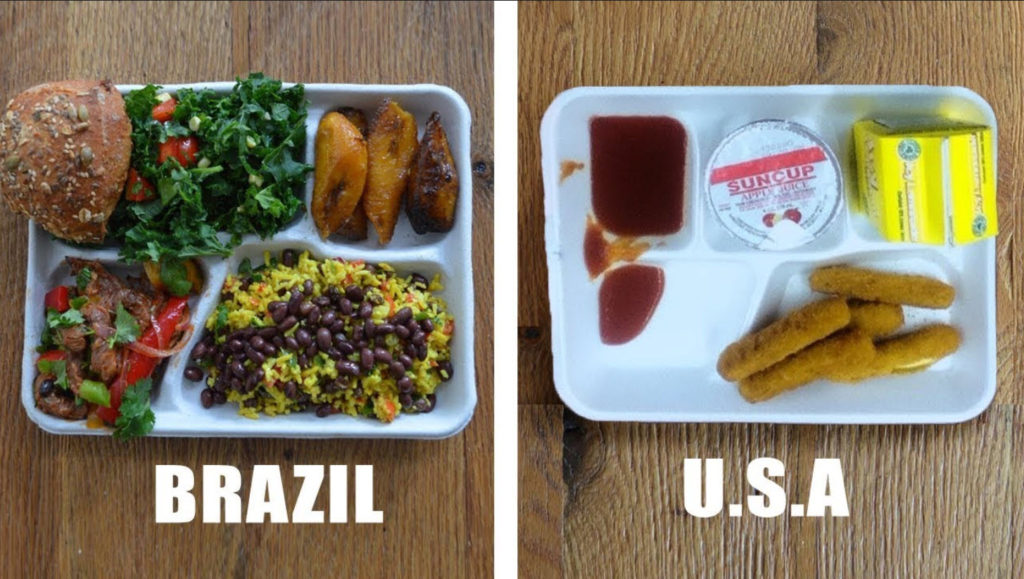
Lesson 2: Craft policies to support small farmers
Brazil has a long history of agrarian activism rooted in the Movimento dos Trabalhadores Rurais Sem Terra (MST) — Landless Workers’ Movement — that emerged in the 1970s to fight for the rights of rural families pushed off their land during years of military dictatorship. The movement is known for bold direct actions, like the massive demonstrations it has organized, but it’s also an effective political force.
In the mid-1990s, it pushed to ensure small farmers could benefit from agricultural policies — like loans, insurance, price stabilization and market access — already enjoyed by big agribusinesses. The government responded with the National Program to Strengthen Family Agriculture — and created a separate ministry for small-scale farming, the Ministry of Agrarian Development. The ministry and the MST were crucial stakeholders in drafting the law mandating 30 per cent local purchasing.
The law has provided an incentive for farmers to organize in co-operatives so they can meet schools’ demands for large quantities of high quality produce.
The AOPA co-operative in Paraná sold about $2 million worth of produce to 382 schools in the state this year. The co-op works with 400 farmers in Paraná and three neighboring states.
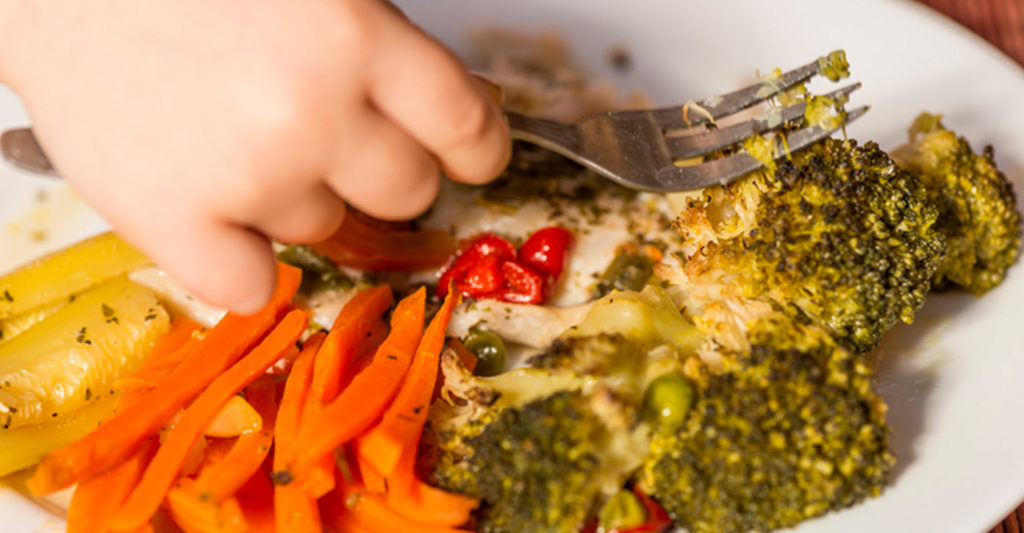
José Antônio da Silva Marfil, the co-op director, told me it has been able to “expand and access more and more opportunities” because of the new demand from schools. The co-op has been able to build new cold storage facilities at its warehouse, and the office now employs a full-time staff of five, including two administrators, two bookkeepers and a floor manager — the people who “make the wheels go ’round.”
“What’s important is that the administrative organization is polished,” Marfil told me. “That’s what makes us work.”
Lesson 3: Regional and local government commitment means more success
Although the PNAE is a national program, state and municipal governments are responsible for implementing it. All states are expected to supplement funding for food (which they do, to varying degrees). Some municipal governments also contribute. State education departments are responsible for food purchasing and maintaining cafeteria infrastructure.
So the program’s level of success depends heavily on how much state and municipal governments consider student nutrition a priority.
In Paraná, for instance, state officials can brag about having one of the highest rates of local food purchasing in the country (40 per cent of food served to students is from local farmers and processors) and one of the highest rates of organic food purchasing. In 2011, they delivered nine tonnes of organic produce to schools; now they deliver 2,414 tonnes.
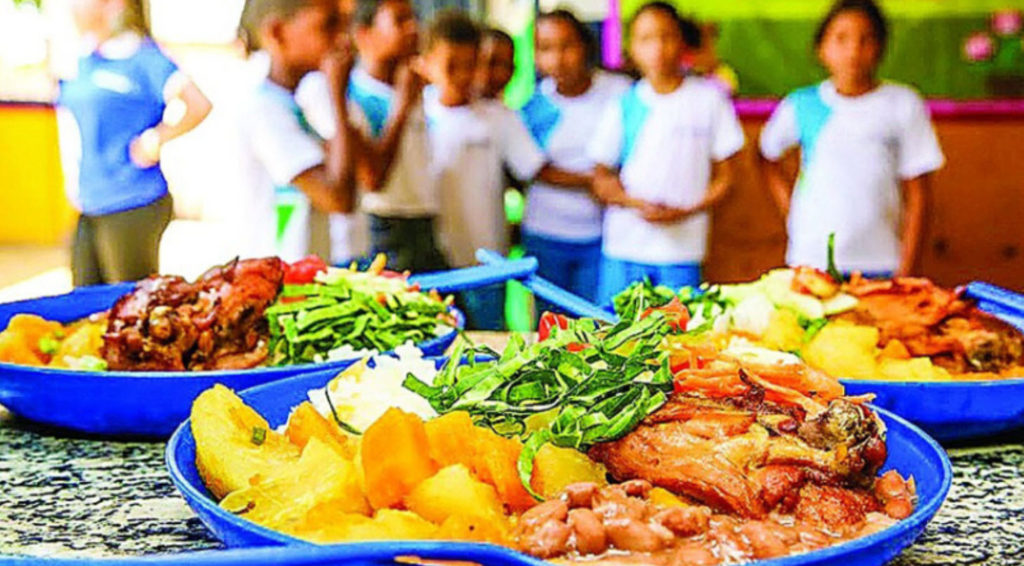
Buying local required a big shift on the part of farmers, nutritionists and school administrators here. The two biggest challenges for farmers who wanted to participate in the program were getting through the application process (which consists of about 28 different forms) and then figuring out distribution logistics. Although non-perishable items go to a central warehouse, perishables must be delivered by the producer directly to schools once or twice per week.
In response, program administrators tried to simplify the process. They revamped regional boundaries to better match participating farmers with schools near them. They created YouTube videos to walk farmers through the application process. And they adjusted produce prices monthly, instead of annually, to better reflect market rates.
Lesson 4: Change can be slow, but will pay off
Brazil’s legislature passed the 30-per-cent local law in 2009. Implementing it required a major logistical shift for state education departments that were used to working with large food manufacturers and distributors. Farmers had to become accustomed to the paperwork required to do business with the state.
Even in states where progress has been slower, the school food program is having positive effects. Bahia, in northeastern Brazil, has not met the legislated goal of purchasing 30 per cent of food from family farmers — last year, it was around 20 per cent. But the year before it, it was only six per cent.
Eleneiole Alves Cordeiro is the manager of a farmers’ co-op in Bahia, Arco Sertão Central, that launched three years ago and now has 47 members producing everything from cassava and papaya to bread and the tapioca crackers that are so popular in the region. She said that although the prices offered by the state government through the program are too low, “it is opening doors for our product, spreading our products and interests in different markets.”
And this exposure is proving that small agriculture can produce good quality processed products — the kind of value-added products that can make farming more profitable.
“This spread, this growth, is breaking a paradigm… the stereotype that people believe that family agriculture does not have good products,” said Cordeiro. “That’s a lie. We know we are able and capable of producing quality products, good, dignified products that can contribute to the school feeding program.”
Lesson 5: There must be broad public support
When Brazil created its national student nutrition program in 1954, it was out of dire necessity. At the time, more than half the children in the country suffered from malnutrition. Much of the food used in the program was a commodity donated by USAID and other wealthy countries. For much of its history, the focus was on feeding kids, not feeding kids well, according to Daniel Silva Balaban, director of the World Food Program’s Center of Excellence Against Hunger.
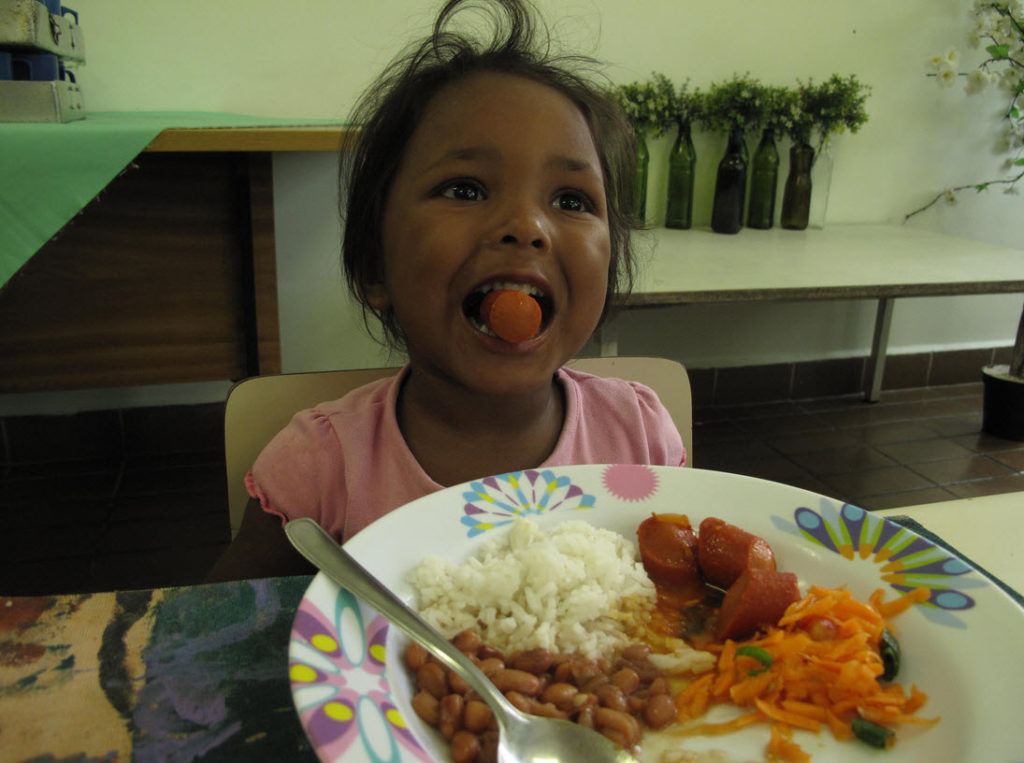
Former president Luiz Inácio Lula da Silva began reforming the national school meal program in the early 2000s as part of a much broader vision for food security known as Fome Zero (Zero Hunger).
By then, Brazil had become an economic powerhouse. Industrial agriculture was booming and there was a rising middle class, but many Brazilians, particularly in rural areas, weren’t seeing much improvement in quality of life. Hunger, although not as prevalent, was still a big problem. People were hungry for change — hungry for a more equitable distribution of resources.
Taiwan (elementary school)
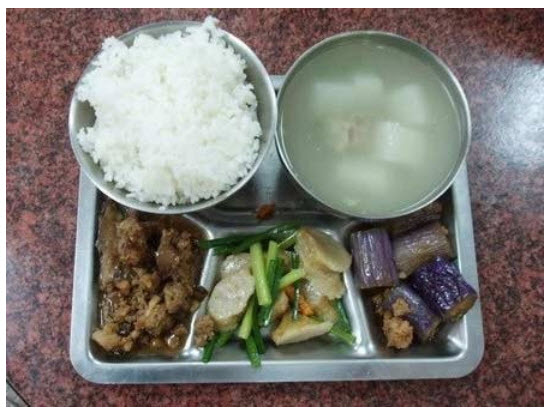
On the left: mushroom and minced pork, in the middle: Chinese chives stir fry with tempura, on the right: eggplant (probably stirfry), soup with radish and pork, and steamed white rice.
Singapore
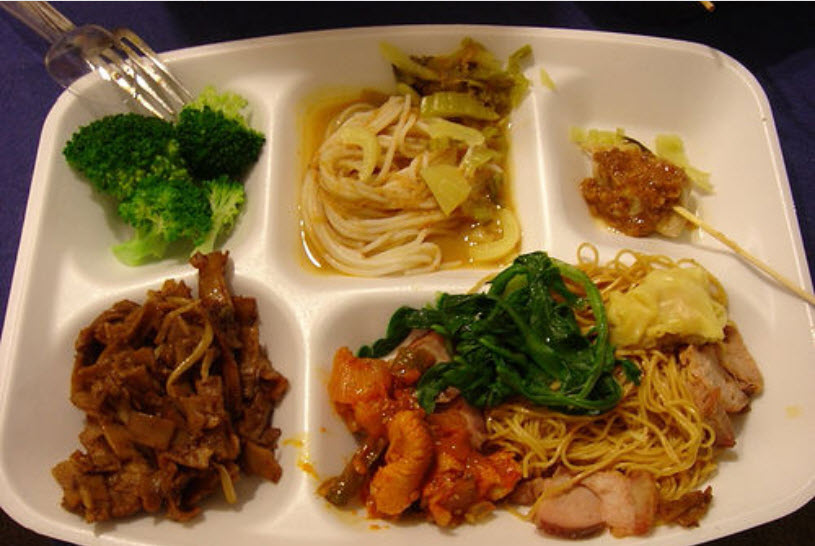
The Singaporean school lunch looks very appetizing with the colorful plate. Singapore, a multicultural society where diverse cultures, languages and religions coexist, has its strength when it comes to food choices and quality. Although Marina Bay Sands is often recognized as the city’s modern landmark, Singapore is also known for its delicious street food.
People buy meals from outside food courts, and Singaporean students enjoy their lunches in the same way. Students in a Singaporean school go to a tuckshop, a collection of different stalls rented to a private cook, and choose between Singaporean and Western food.
Spain
From Medideas… Titled “School Lunch in Spain vs. School Lunch in the US” (all credit to the author)…
My memories of cafeteria food from public school in North Carolina are less than glamorous. I recall plenty of fish sticks, powdered mashed potatoes, questionable ground beef, and the occasional cup of bright green sherbet.
But at Colegio Santa María del Bosque, lunchtime is a very different experience. Every meal consists of two courses, served family-style in huge metal bowls.
Some aspects of school lunches in Spain are similar: the never-ending noise, the barely contained chaos, and the long tables reminiscent of those I used to sit at as a student. However, at lunchtime in Spain, there are no lines, no trays, and definitely no neon dessert.
Not to mention the fact that a team of sweet, smiling women prepares and serves the food. Indeed, these women take pride in feeding the army of kids and teachers that descends upon them each day; a far cry from the perpetually grumpy lunch ladies of my childhood.
What Are Spanish School Lunches Like?
On my very first day of school, I sat down with the other teachers at a table across the room from our students. I was entirely unsure of what to expect, as it was my first school lunch in Spain.
Within a few minutes, one of the lunch ladies brought out a heaping dish of paella: steaming yellow rice dotted with carrots, peas, potatoes, and tender pieces of bacalao (cod).
Of course, this wasn’t the same as the version I’d eaten in Barcelona at a touristy waterfront café; no cast iron skillet, no plump prawns, no mussels or clams, or sprigs of parsley. And I’m sure it bears little resemblance to the authentic delicacy you can only truly taste in Valencia, where the dish originated.
But on my first day of teaching, after trying to keep a group of exuberant eight-year-olds under control for an hour, this paella could not have tasted any better.
Typical School Lunches in Spain
In the months that have passed since that first day, school meals in Spain have rarely been disappointing. Generally, I enjoyed the food laid in front of me each afternoon. I have feasted on the simplest “tortilla española” in all its greasy delight; and warmed my soul with “solferino” and “crema de calabaza”, thick and hearty vegetable soups. I have stuffed myself with salty slabs of thinly sliced pork atop lettuce and tomatoes drowning in vinegar and olive oil. I have been introduced to “cocido”, the classic “madrileño” comfort food consisting of broth, noodles, stewed chickpeas, garlicky cabbage, various meats, and chunks of pure fat. And I have ended every meal with a piece of fresh fruit: apples, bananas, mandarin oranges, plump green grapes, and slices of juicy melon.
This alone is enough to forever cement in my mind the superiority of school lunch in Spain. Who needs powdered chocolate pudding when you’ve got good old-fashioned produce?
The Not-So-Great Side of School Lunch in Spain
Of course, there have been a couple of dishes that even I—a fairly adventurous and open-minded eater—have regarded with suspicion. Hard-boiled eggs covered in mayonnaise? Maybe not.
Pasta salad with tuna and black olives? Not my personal favorite.
And there’s no doubt that one would enjoy some of the typical Spanish dishes at my school more if they didn’t prepare them in industrial-sized batches. However, I am determined to give all of it a try, at least once.
If there’s anything I’ve learned from my time in the comedor (cafeteria), it’s that sometimes the most delicious and satisfying meals are truly found in the most unexpected of places. Namely, on plastic plates at a kid-sized table in an underground room filled with dozens of shouting children. ¡Buen provecho!
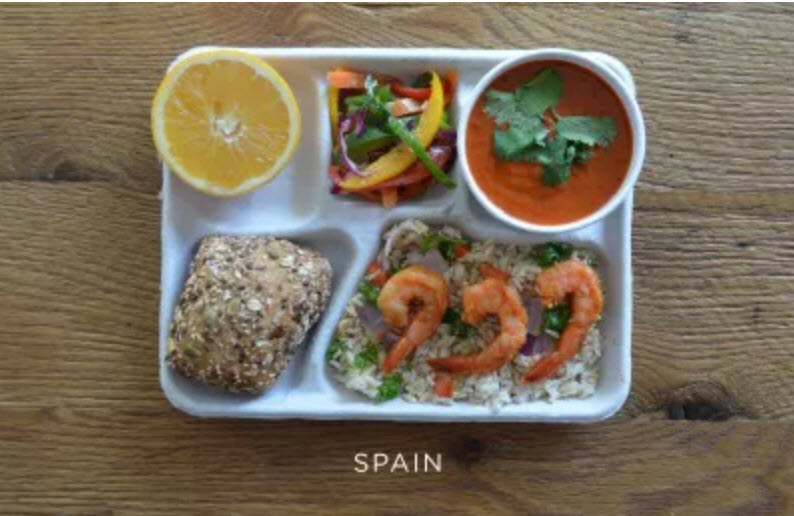
Thailand
From Thai School Life, and credit to the author…
Today I want to talk a little about the steps students go through to eat at school. As you can see in the top picture, the students are all lined up to receive a bowl of rice soup from one of the serving ladies. What makes this a little different to Western countries is that the students will “wai’ and say thank you before they take the bowl of food. This is ingrained into the students. They must always “wai” first before receiving anything.
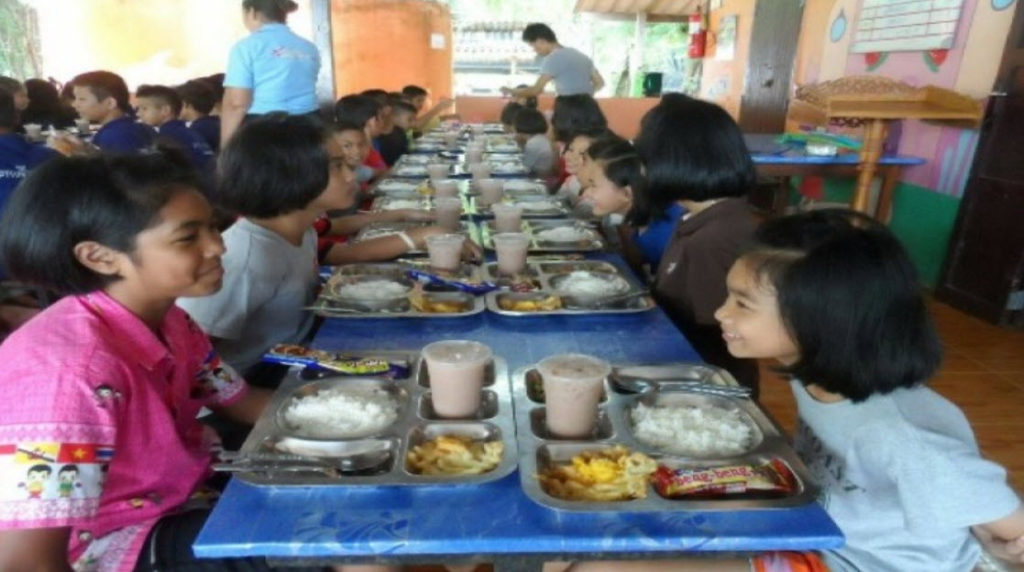
Other schools, particularly the secondary schools, are a little different to us. They might have lots of little stalls in the canteen and the students can choose what they want to eat every day. At my school, the menu is set and there is a four week rotation. In total we have 20 meals which I will tell you more about later. So, the students all eat the same. No-one brings food in from home. By far the majority are Buddhists and maybe only a handful are Muslims.
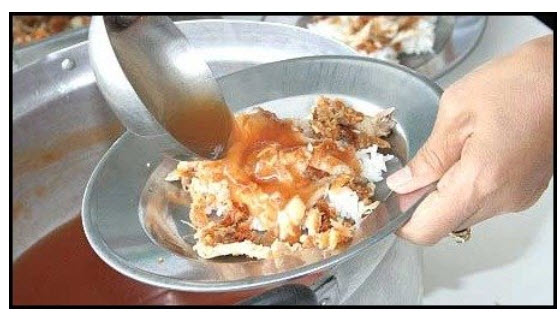
On most days, there will be a tray of condiments which the students will use to make their meal more tastier. In some ways you have to be a bit of a scientist to get the proportions right of sweet, sour and spicy. But the students know what they are doing and some like adding chili until the soup runs red. Actually, this is one of the good things about eating noodle soups in Thailand. What the vendor will give you is bland and not spicy at all. It is then up to you to add the different sauces to your own satisfaction. I will go into more detail another day.
Back in the classroom, the students wait for their friends to sit down. We now have too many students and it is easier for everyone to eat their lunch in the classroom. Once everyone is sitting down, the students will then say a kind of grace. This is not really religious but more ethical. It is reminding them that they should eat properly and that they should be grateful to the people who provided them with the food. The following translation of the grace was done by Gor when he was my Primary 6 student a number of years ago.
“During the time that we eat lunch, don’t speak or say things that aren’t good. Don’t make a noise. Take enough food for only one mouthful. Chew the food into little pieces so that you can digest the food properly. Before you get up from your seat, clean up your desk. Put the plate or a bowl orderly into the enameled basin. You mustn’t waste any food. You must eat it all. There are many starving children in the world. Pity all of the children that don’t have anything to eat. All of the food has a worth. When you eat food you must have good manners. Don’t chew the food loudly. Don’t talk when you are eating and don’t say something that is bad. Don’t laugh when you are eating. Thank you to our teachers that take care of us and all of the cooks that make us the food we eat. Thank you. Thank you. Thank you very much.”
After that they then start eating. Everything is done very orderly and the students eat quietly. When they have finished, they put any waste food in a plastic bucket and their plates in an enamel bowl. Students who are on duty for that day will clean the classroom and then take the dirty plates and waste food down to the kitchen. Waste food is later fed to the stray dogs.
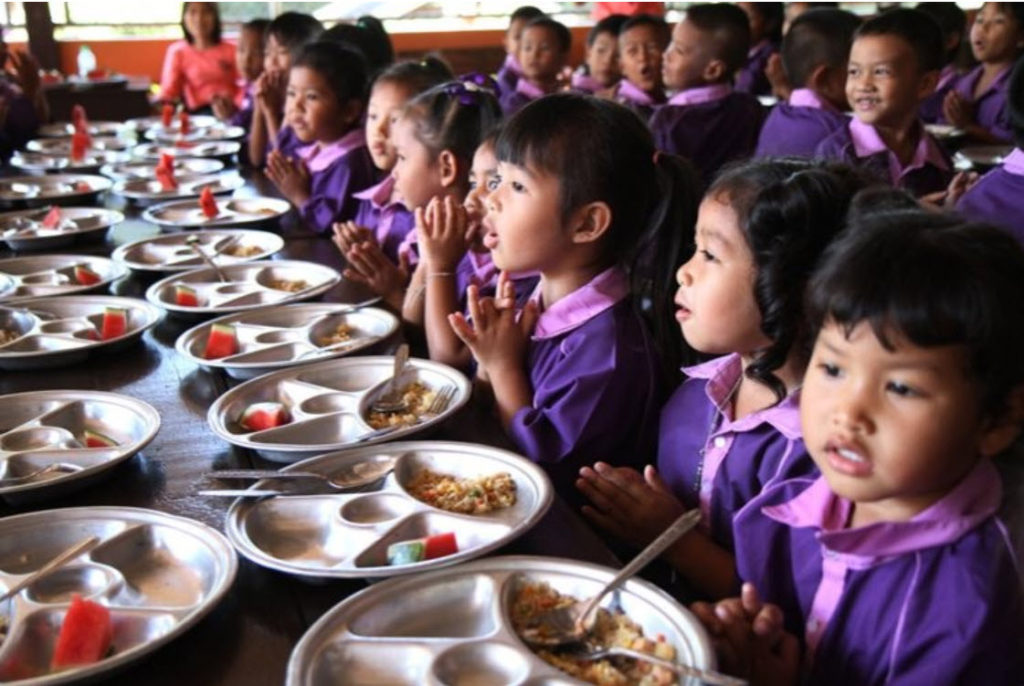
The plates are washed by the kitchen staff. However, the spoons and forks (they don’t use knives or chopsticks) are washed by the students on duty. After they have finished eating, many of the students then go to brush their teeth.
This is what the students eat over a four week period. There are actually three different menus: kindergarten, junior school and senior school. As there are some repeats I will just give you the menu for the older students. Not everyone eats the same thing at the same time. There are 1,800 students (and one small kitchen) so not everyone can have a rice based meal at the same time. So, half of the school have rice while the other half have some kind of soup.
Czech Republic elementary school lunch
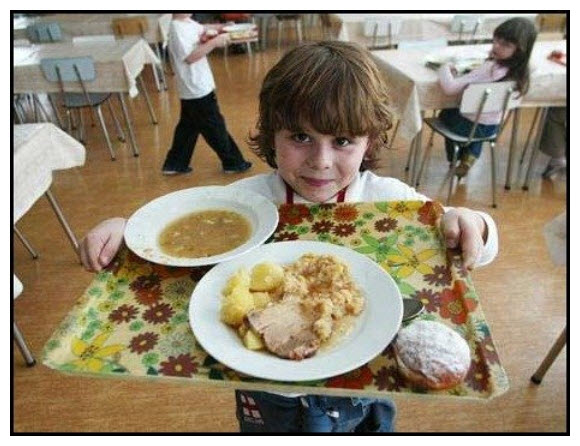
Lunch usually consists of soup and a main course. Usually, there is a salad or some sort of fruit along with something sweet for dessert. There is always tea and water with sweet syrup on tap and cacao if sweet buns are for lunch.
Most of the kids eat at the school canteen (cafeteria). It’s convenient and cheaper for many parents.
Finland
In the beginning of the 20th century Finland developed an incredible social innovation: free school meals. Many of its other national success stories have been made possible thanks to our education and school meal system. Its goal is to make the world’s best school meals even better and help others in their work.
During 70 years, Finland has come a long way to become the international forerunner we are today. There is now a versatile and unique food education agenda that has grown around the school lunch. The basis has still remained the same: to each equally, during every school day.
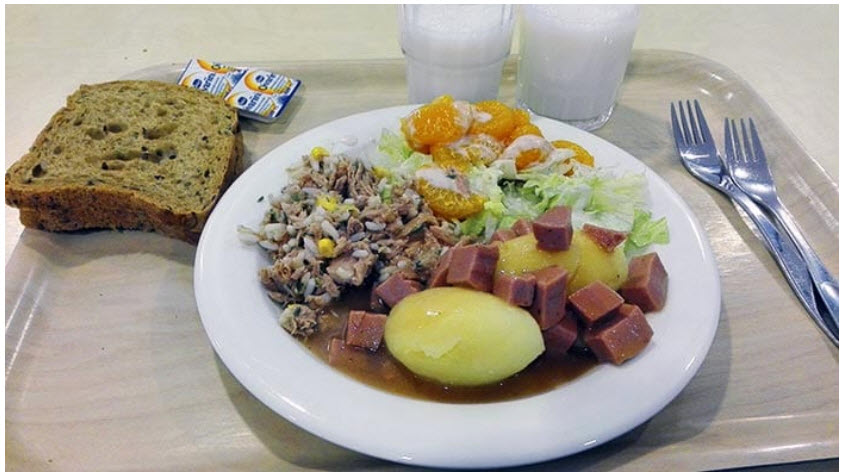
Potatoes and sausage bites with gravy, rice & corn tuna salad, Iceberg lettuce with tangerines and dressing. Served with a slice of bread, butter and skim or low fat milk.
The Finnish government (like most European nations) provides children with free school lunch. Finnish children have been receiving free food for over 60 years, and some cities extend free food service to people who can’t afford for the adequate nutrition intakes.
Food is very important for child development mentally and physically, and Finland obviously knows how to take a wholesome care of citizens. There is no wonder Finnish kids exceed academically among those in other countries. In general, the winter in Finland may be colder than your cities, but those people are big-hearted.
South Korea
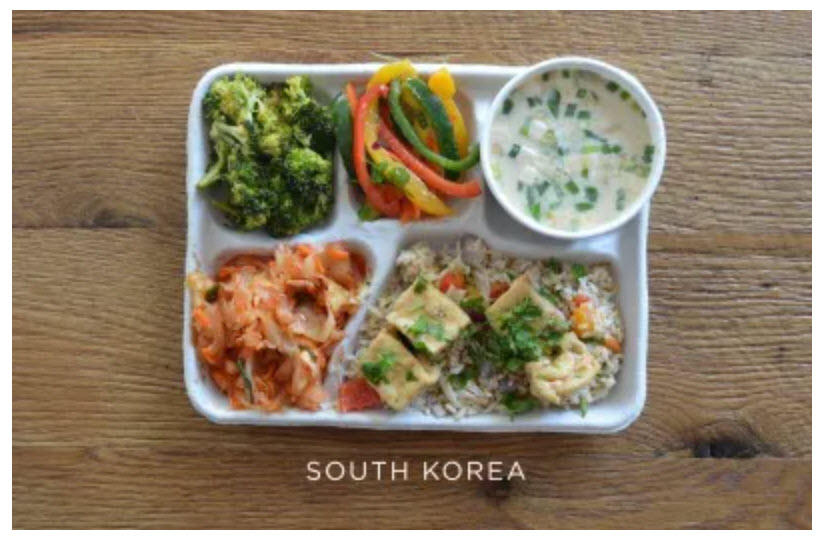
The Korean lunch looks very healthy, as expected. Korean people are very health-conscious, and this well-balanced lunch explains it well. The menu contains raw vegetables, spicy marinated pork, soup and rice. At a Korean restaurant, you are often served with Banchan, small dishes of food in the middle of a table to share. This lunch reflects the idea of Banchan: small portions of everything.
Sweden
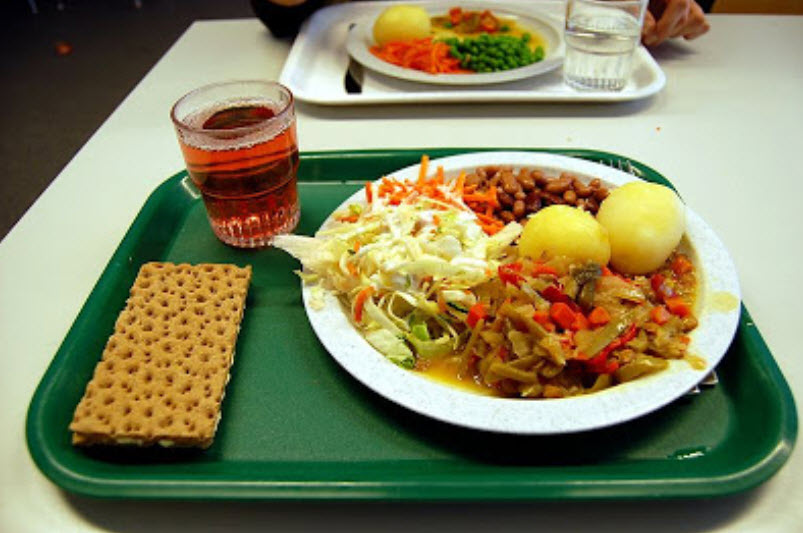
Swedish lunch is typically served with a warm main dish, like a stew with potatoes, with a side dish. The side dish contains “knäckebröd,” the famous Swedish crispy bread, and salad or cooked vegetables. Students can choose to drink water, milk or lingonberry juice, which is known as mountain cranberries or partridge berries in North America. Swedish students get more than 2000 school lunches during their years of compulsory education.
Ukraine
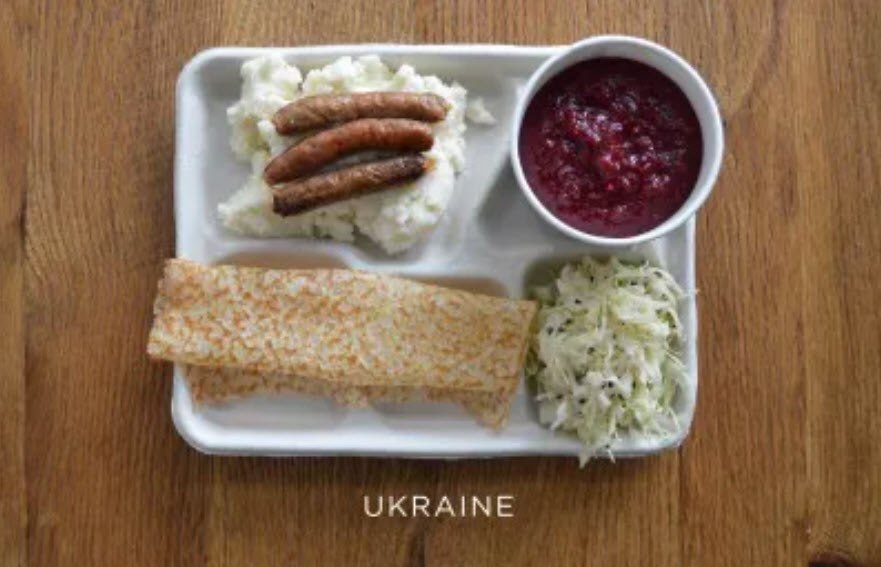
Malaysia


To get his Malaysia photographs Dave talked his way into the cafeteria at an elementary school in Brickfields, more popularly known as one of Kuala Lumpur’s Little Indias. I didn’t accompany him on this adventure, and Dave didn’t taste the food; he remembers each lunch costing around 2 ringgit, or about 60 US cents.
The meals look decent enough, though the roti — which Dave notes wasn’t freshly made (he did arrive close to the end of lunch hour) may be a bit tired. A bowl of asam laksa makes for a fairly well-rounded meal … but candy bars and super-sweet pink drinks?
Both of these lunches say much about what figures large in the local cuisine. In Sichuan, as we found at humble restaurants in Chengdu, rice (or other starch) is still an important part of the meal, and is eaten in great quantities. Vegetables too — not just because they’re cheap, but because Sichuanese love them (and do wonderful things with them). Chilies are present in decent quantities in two out of four dishes, and when there’s meat it’s pork.
In Malaysia eating chilies from an early age is a given, and strong flavors too (but not alot of vegetables). How many American kids would opt to eat a spicy, fish-based noodle soup if they had a choice? And the Malaysian palate, viewed through these two randomly chosen school lunches at least, is truly multi-cultural — a southern Indian bread and a noodle soup with Malay and Chinese culinary roots.
Italy
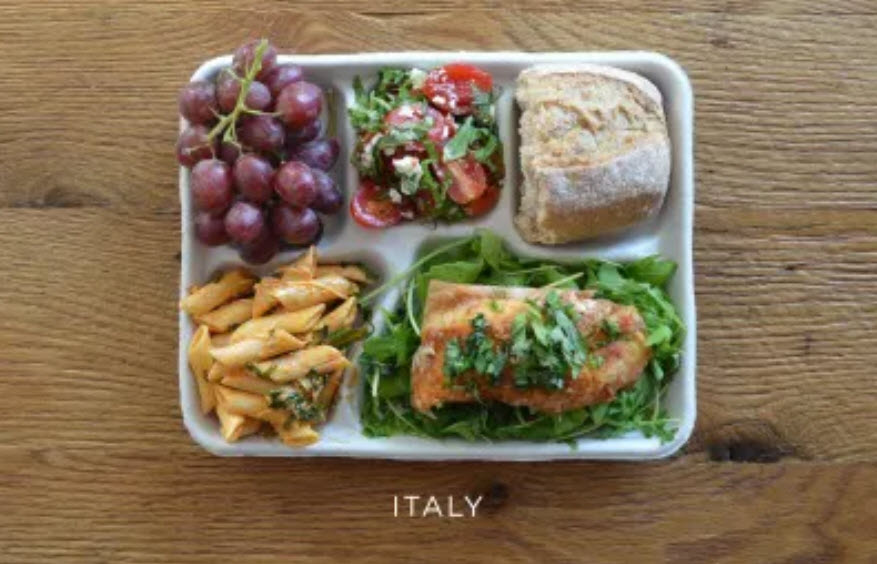
Conclusions
Yeah. It appears that the United States has the unhealthiest meals for its’ children, managed in such a way to allow for massive graft and corruption, and distant unmonitored control.
The idea that there are “nutrition experts” concocting the meals at American schools is ludicrous.
What we see when you step out of the United States Pro-America “echo chamber” is a world where America appears pathetically inept, to a point of being cruel. And we can see this.
Obviously since this has been going on for decades and any efforts to change the system has failed. It appears that the entire system is beyond redemption and must be scrapped and changes implemented on the local level with no external influences or input.
The only way that this type of innate and obvious criminal activity can be allowed to continue for so long, with so little change, implies that the leadership controlling these system are themselves corrupt, corrupted, or being lead by greedy psychopaths.
There is no way that a reheated salt and fat laden hotdog with a dab of sugar-saturated ketchup qualifies for a “healthy nutritious” meal.

And when you see enormously obese Americans riding government supplied electric carts to buy 24-packs of soda, you can rest assured that the American leadership wants this situation;
They planned for it, and they created it. It’s intentional. It is impossible for this condition; this situation to be accidental.
The only way out…
…is to nuke from orbit.

Do you want more?
I have more posts in my Life and Happiness Index here…
Life & Happiness.
And / or my food index here…
Food Index!.
Or the master index here…
Master Index.
Articles & Links
You’ll not find any big banners or popups here talking about cookies and privacy notices. There are no ads on this site (aside from the hosting ads – a necessary evil). Functionally and fundamentally, I just don’t make money off of this blog. It is NOT monetized. Finally, I don’t track you because I just don’t care to.
- You can start reading the articles by going HERE.
- You can visit the Index Page HERE to explore by article subject.
- You can also ask the author some questions. You can go HERE .
- You can find out more about the author HERE.
- If you have concerns or complaints, you can go HERE.
- If you want to make a donation, you can go HERE.
Please kindly help me out in this effort. There is a lot of effort that goes into this disclosure. I could use all the financial support that anyone could provide. Thank you very much.

